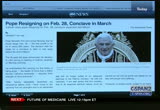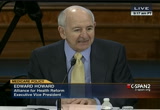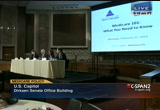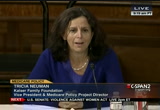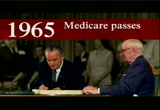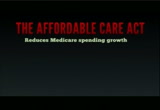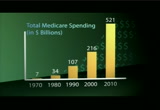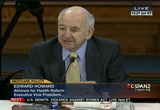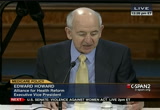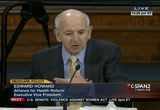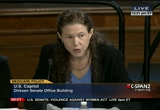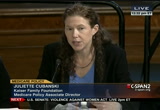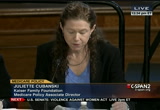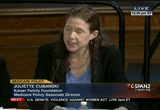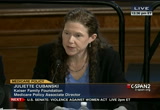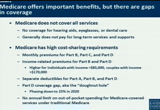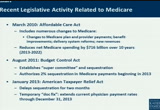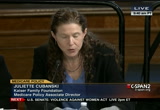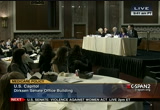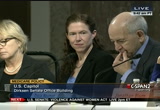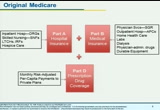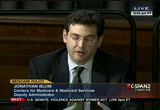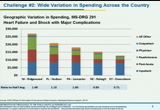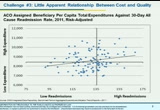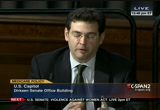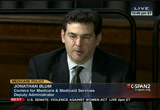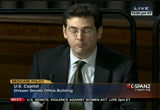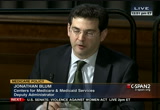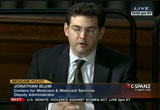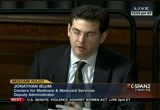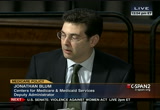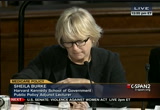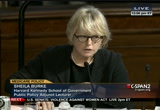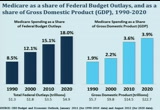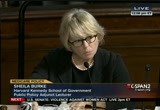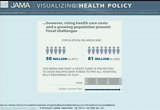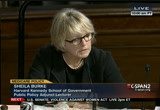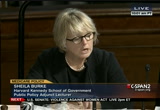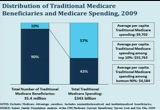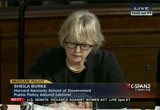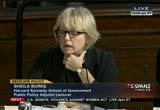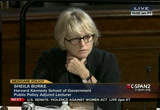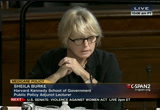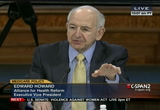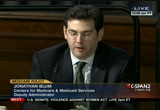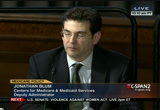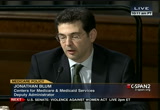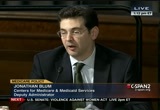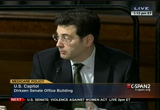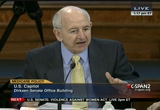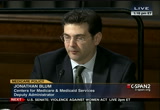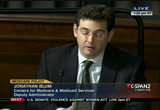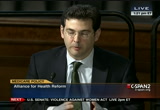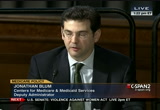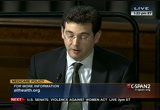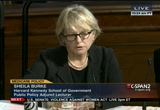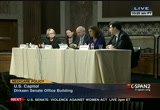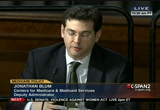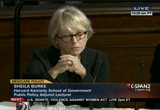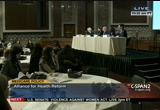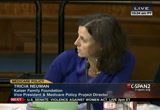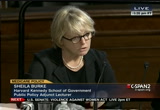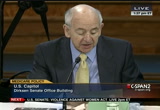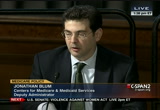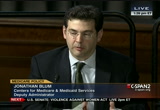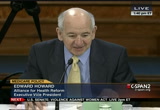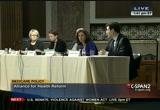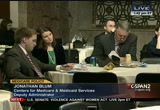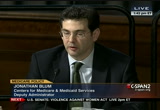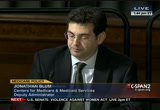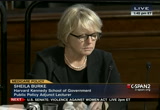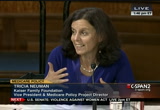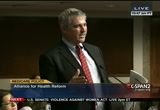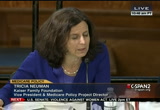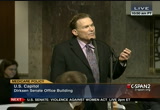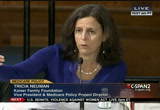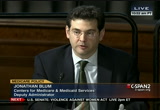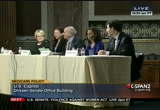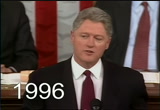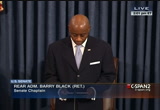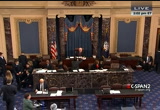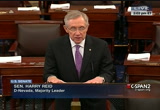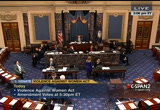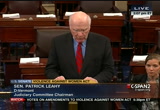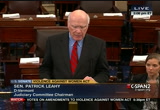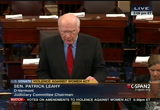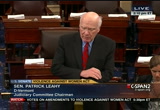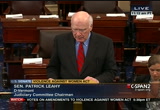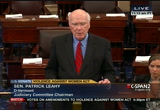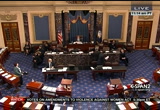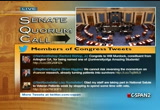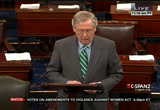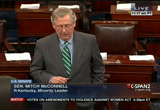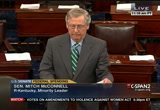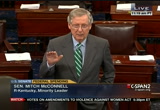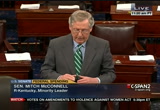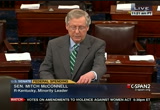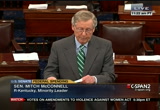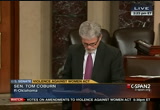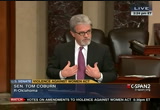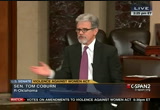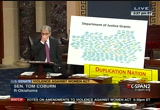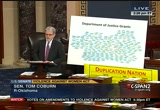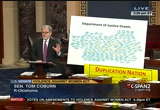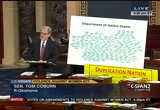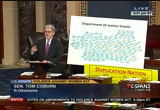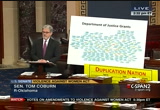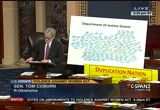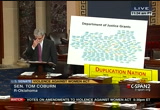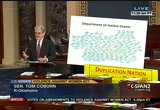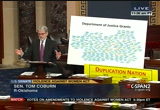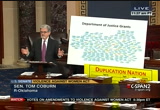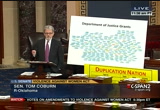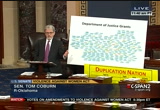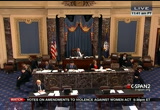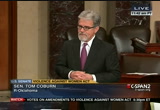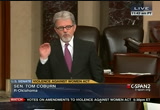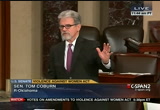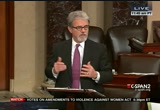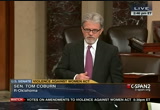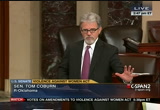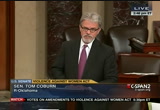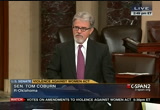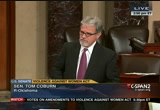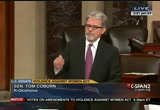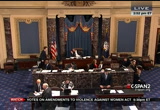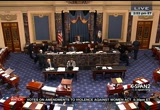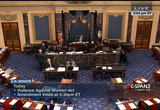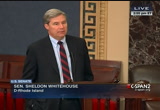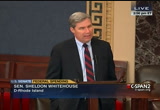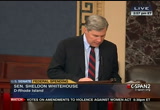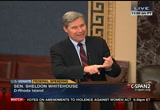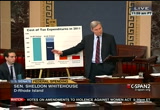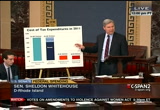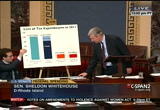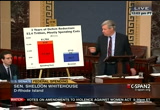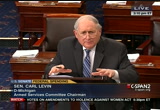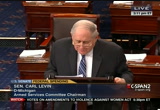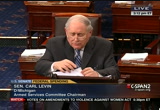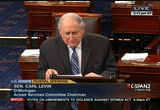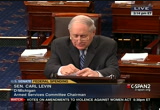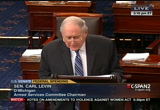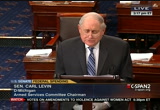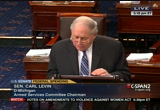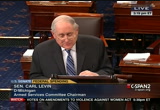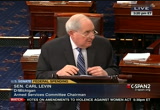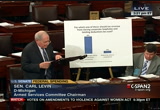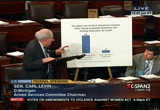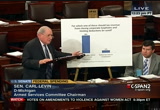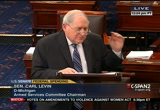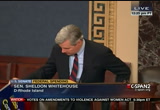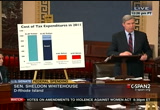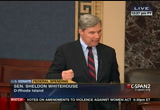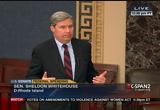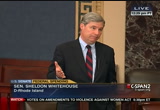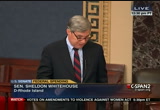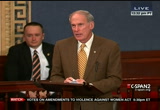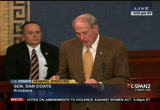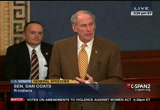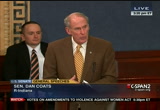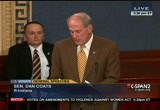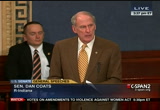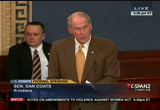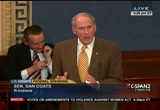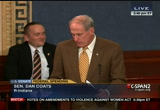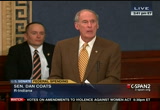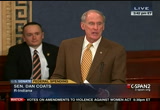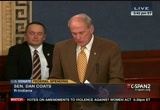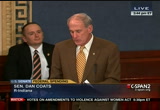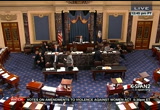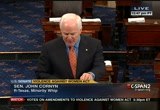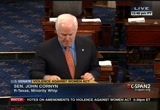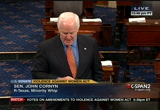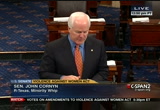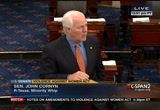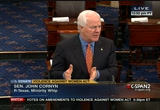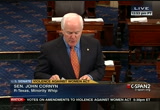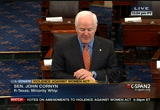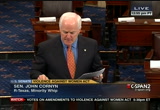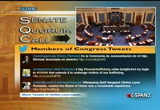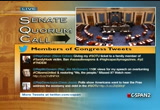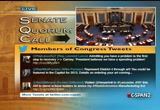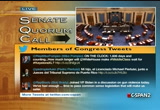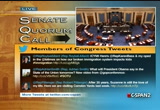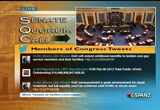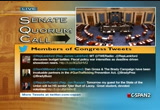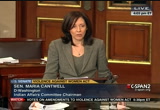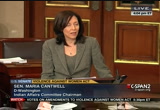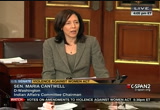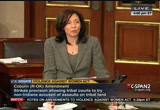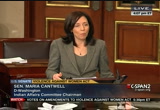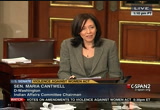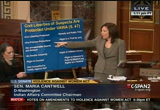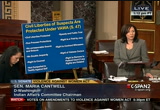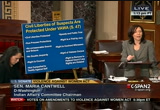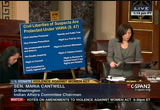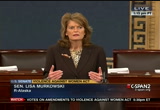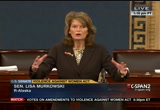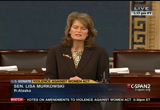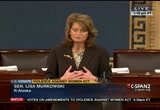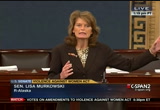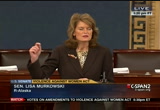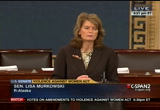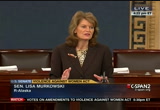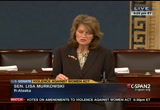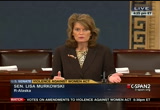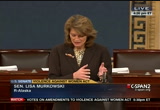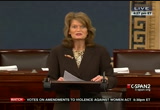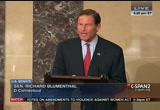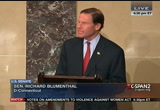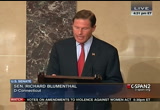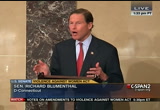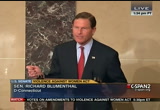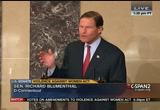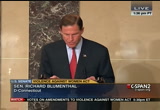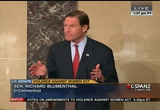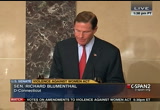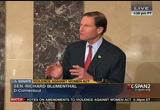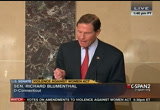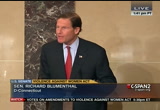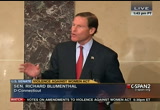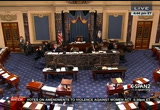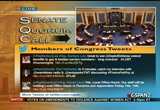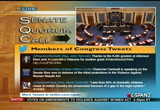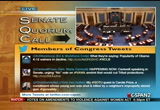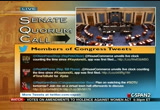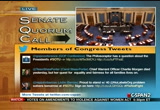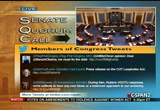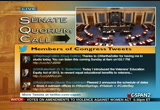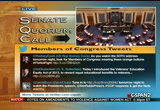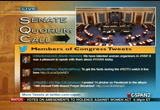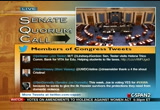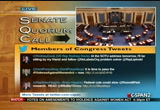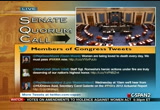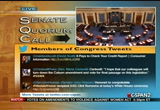tv U.S. Senate CSPAN February 11, 2013 12:00pm-5:00pm EST
12:00 pm
>> host: he emphasized that carrying out the duties of being pope, the leader of more than a billion roman catholics worldwide, requires both strength of mind and body. after having repeatedly examined my conscious before god, i have come to the certainty that my strengths, due to an advanced age, are no longer suited to an adequate exercise of the ministry, he told cardinals. so that is an ap story this
12:01 pm
morning. the latest just breaking this morning around the six a.m. eastern time. back to our question, though, for all of you. sequestration, march 1st is the deadline. republicans want spending cuts, democrats are asking for more tax increases. tim in arkansas, democratic caller, what do you think? >> caller: hello. >> host: hi, tim. you're on the air. bring our troops home and no more taxes. we're taxed to death. i've had enough of taxes. i can't pay any more of my income in taxes. >> host: you say bring the troops home. what do you think about military spending? >> caller: we need to bring our troops home, period. you don't see china, russia going all over the world, you know, being the world's policemen. it's time we stop. >> host: okay, and we increase spending that way? >> caller: yes. it's time we embraced sanity instead of insanity. >> host: all right. june in norfolk, virginia, a republican caller.
12:02 pm
hi, june. >> caller: hi. we've got to get rid of these taxes. this is just too much. we gave in already once. we've give in several times -- we've given in several times. we've got to stop the spending. it's, we are, you know, we've got, we've got socialistic governments all over the world. if that's what you want, please, get on a plane and go there and live. >> host: so, june -- >> caller: we have got to get our country under control. >> host: so, june, do you think republicans should hold that line and let sequestration happen if they, if democrats will not agree to spending cuts? >> caller: well, they're not going to agree to spending cuts. they have all of the press, and it is spun every day. we hear nothing on the media about the fact that we are taxed too much. >> host: okay. >> caller: so they've got no reason to give in. they've got a president who wants to turn us into a third world country with all this
12:03 pm
taxing and redistribution of wealth. we've run out of wealth, by the way, it's just redistribution the crumbs on the table. and it's just too much. >> host: all right, june. let's listen to what nancy pelosi had to say. she was on the sunday talk shows yesterday, and here's what she had to say on this issue of a spending problem in washington. >> so it is almost a false argument to say we have a spending problem. we have a budget deficit problem that we have to address. right now we have low interest on the national debt, and a good time for us the to act to lower that deficit. we think the deficit and the national debt are at immoral levels. we think they must be reduced. we're sick and tired of paying interest on the national debt, and that's 15%. that's a large percentage of the budget. it's lower now because of the lower interest rate. >> host: so on this debate, spending cuts versus tax increases, here's what the washington times writes in their
12:04 pm
12:05 pm
medicare and medicaid are the biggest culprits in the spending spike. these entitlements were responsible for about 5% of federal be spend anything 1950, a figure that jumped to almost 16% in 2010. >> host: that's the washington times editorial this morning. we'll go to bob in freeburg, pennsylvania. democratic caller. hi, bob. >> caller: good morning. >> host: good morning. what are your thoughts? >> caller: i think that you're looking at the wrong problem. i think the problem that's facing the country is the growing disparity in wealth between the rich and the poor. we've got a minimum wage of seven and a quarter right now. now, if it had kept up with inflation, it would be around ten dollars and a half. when you get people who are
12:06 pm
collecting all the programs, you know, for them to go to work it's like they're working for $2 an hour over what they were getting before. now, of course, they don't want to work at that rate. i think that if you raise the minimum wage to where it should be, say it was around $10.50, i think president obama suggested $9.50 at one point but nothing was ever done about it, it would take a lot of people off of welfare and put 'em back to work. and that's what we really need. >> host: okay. all right. joyce in bethesda near maryland, republican caller not too far from the capitol, go ahead, joyce. >> caller: good morning. >> host: morning. >> caller: and thank you very much for c-span. i wanted to bring out, first of all, we want them to cut spending, but more importantly than that, we want them to address this issue of drugs in our schools. we met with president obama's drug policy staff on the 23rd of
12:07 pm
january asking them to do this and telling them that we really held them responsible for, actually, treason against children. if you're, if you are violating a and certainly our children everywhere taking, taking into consideration the children in connecticut who were 20 babies killed, and we all believe that somewhere along the line there's a drug issue involved here. >> host: so, joyce, when it comes to spending cuts, are you saying, yeah, we need to cut programs but not my program? >> caller: well, not the children's programs. for 20 -- for, actually, 30 years we've been fighting against drug legalization in this country. and we now know that there are many members of congress, actually, who are not too far
12:08 pm
from voting on this issue. >> host: okay. i'm going to leave it there, joyce. baltimore sun, front page in this morning about president obama's state of the union address which he will give tomorrow night, obama's speech to focus on jobs and the economy. he'll also touch on climate change, immigration and guns. that's the baltimore sun this morning. and then "the new york times"' front page, obama to renew drive for cuts in nuclear arms. the president will use his state of the union address on tuesday to reinvigorate one of his signature national security objectives, drastically reducing nuclear arsenals around the world. >> host: so in his state of the union address he will also be focusing on that, and that is tomorrow night. also the fed page this morning of "the washington post," being first lady's guest can be a game changer. it has a little history in "the washington post" this morning about the first lady and their
12:09 pm
guests. and emily kyle writes hundreds of people have sat in that box since first lady nancy reagan invited lenny to join her for the 1982 address. a federal worker who plunged into the chilly potomac river to save a survivor of an air florida flight there spawned the tradition of inviting everyday americans to the speech. so that is how the tradition started, and first lady michelle obama expected to have guests in many her box relate -- in her box related to the issue over gun control. our coverage here on c-span for state of the union address starting at 8 p.m. eastern time here on c-span, c-span radio and c-span.org for more details. back to question for all of you about sequestration. spending cuts versus tax increases? what do you think should happen? should there be compromise perhaps? john mccain, the senator, republican, from arizona sparked this headline in "the washington
12:10 pm
post": mccain says maybe to new taxes to avert sequestration. here's what he had to say. >> the president is the same one that during the campaign said it's not going happen. remember that? he just dismissed it. and a lot of us, in fact, lindsey graham, kelly ayotte and i were traveling around the country warning about what was going to happen as a result of sequestration, and it is devastating. the world is very dangerous. i'm sorry i'm a little emotional about, but the men and women serving in the military deserve better than what they're giving -- what were given them. they don't know what they're going to be doing tomorrow. we just delayed the deployment of an aircraft carrier. the cuts are coming across the board. the consequences are severe. it requires a bipartisanship. would i look at some revenue closers? maybe so. but we've already just raised taxes. why do we have to raise taxes again? >> in his state of the union speech, aides say that the president is going to call for
12:11 pm
new investment/spending on education and energy and infrastructure and manufacturing to try to boost the economy and to boost the middle class. will you go along with that? >> as long as we pay for it. we've seen this movie before. we saw it with the so-called stimulus package back in the beginning of the administration, and and we saw the longest, most stagnant economy in history and now a debt and deficit that's $53,000 for every man, woman and child in america. >> host: senator john mccain on fox news sunday. the washington times' front page has the story about those military spending cuts that the senator was talking about with this headline: military warns cut cans would create hollow force akin to the 1970s. army brigades won't be ready to fight, navy aircraft carriers won't deploy, the air force won't be able to operate radar surveillance 24 hours a day.
12:12 pm
the dire scenarios are contained in a series of memos sent to congress and obtained by the washington times. >> host: so that is on the table as well under sequestration, detention and nondefense spending cuts across the board. we're talking about 85 billion. the president wants tax revenues to be part of the debate. he's also calling for some short-term deal to avoid sequestration altogether. mark in michigan, independent caller. mark, as an independent, what do you think? >> caller: well, unfortunately, there is the silver bullet that our esteemed politicians can't offer the public. it's called a seven-year tax cycle.
12:13 pm
prorated one year, everybody that's working will have a chance to not pay federal tax one year, which means everybody that's working is going to get one-seventh of whatever he paid in fica, the city, state, federal, any tax on down. they'll get one-seventh of that back. then the system in government could raise tax on whatever issue they pretended to want to pay for, and the people know they don't have to cover the government's inability to pay for it since all they've done is raise the debt or done nothing to put anything down on the deficit. from that standpoint there, it's political fraud by the politicians. i don't know what else to say. have a good day. >> host: all right, mark. a couple tweets for you here. cut it, cut it, cut it is what he has to say on our twitter page. and steve harrison, spending cuts versus tax revenue, it's not necessarily an either/or situation. but more tax revenue has to be on the table. arkansas dell in idaho, excuse
12:14 pm
me, republican caller. >> caller: yes. i think we need spending cuts. we don't need any or more rev of knews. they keep -- revenues. they keep spending more money the more money we put into it, the more they spend. they don't care, take care of what they already have. >> host: okay, ardelle, the baltimore sun reports this, this morning, that obama will travel to three states after his state of the union address in the span of three days going on the road to drum up support for his proposals. >> host: front page of "the chicago tribune" this morning, courtesy of the newseum, says president obama to talk guns in chicago. activists help visit turns tide on killings. that's front page of "the chicago tribune." sequestration, spending cuts versus tax increases.
12:15 pm
fred, you're up next. westen, virginia, democratic caller. >> caller: hello? >> host: hi, fred. >> caller: yes, good morning. i agree -- i'm sorry. i agree for spend cut and tax -- [inaudible] use both of them. >> host: we need both of them? >> caller: yes. and the other point i want to make is -- [inaudible] because i have to go out in the world and help other countries. i believe that america is superpower and is the only one, and this start 150 years ago. we cannot say, no, we don't want to because it's tough. and the other hand, nobody goes to china and russia to immigrate because they don't like the manners. and the united states is a mixed generation now, is from africa, is from 200 different countries with 64 different languages.
12:16 pm
so when you say america is -- [inaudible] or black -- okay, fred. senator dick durbin, democrat of illinois -- >> we're going to leave this conversation now, take you live to an alliance for health reform briefing on medicare policy and the future of the program. and how medicare is funded, who the beneficiaries are and what changes are set to occur once the health care law is fully implemented in 2014. live coverage here on c-span2. [inaudible conversations]
12:17 pm
>> microphones, and this one is on. [laughter] thank goodness i didn't tell that off-color joke while we were waiting for sheila berg to show up. i'm ed howard with the alliance for health reform. i want to welcome you, thank you for coming. this is a program on the basics of medicare, and on behalf of senator blunt, senator rockefeller, our board of directors, i want to welcome you to this program which we think is a pretty important one. it's sort of the building blocks of the rest of the congressional debate about medicare. it's the largest federal health program covering -- in terms of dollars -- covering 50 million people at a total cost, a total this year approaching $600 billion. it was enacted back in 1965. i first came to work on the hill in, are you ready for this? -- 1969. and i can't remember a single
12:18 pm
year since then when congress hasn't done something important with the medicare program. this this is a huge, popular and expensive program. it delivers health care to almost one in the five americans, particularly those over 65 and those with a disability. so there's a need for all policymakers to understand how medicare works. plus there were some stamm changes -- substantial changes to the program in the affordable care act in 2010, and we'll hear about those changes as well today. our partner and co-sponsor in this briefing, the kaiser family foundation, turns out some of the best, most understandable analyses of medicare you're going to find. and the person who is responsible for a large part of that analysis is here today to co-moderate this session, and
12:19 pm
i'm talking about trisha newman on my immediate left. she's a senior vice president at the foundation and director of the kaiser program on medicare policy, and we're very pleased to have you and kaiser involved in today's briefing. tricia? >> thank you. um, thank you, ed. it is great to be here, and i'm so glad so many of you are here for what we've sometimes called medicare boot camp. we have some terrific speakers to provide a great overview of medicare, how it works, who it serves and some of the challenges that the program faces. and i'm going to turn it over to them in a minute. but first, we have something kind of fun for you today, i hope it's kind of fun. we are going to do the capitol hill release of a video that was prepared by my colleagues at the kaiser family foundation which shows that history -- the history and timeline of medicare. it's short, it's entertaining, but it provides a lot of information in a short period of
12:20 pm
time, so i think without further ado, we'll go right to that. and with apologies that we don't have popcorn for you for the movies. ♪ ♪ >> in the depression the elderly were quite dependent on their sons and daughters. and the sons and daughters were out of jobs. ♪ ♪ >> and the principal problem was medical care costs. not that people couldn't get good care, but it was that they could not afford it, particularly they couldn't afford the hospital costs. >> there wasn't much of an argument about the need. the argument was what to do about it. ♪ ♪
12:21 pm
>> they thought it would help elderly people in the south. but what happened was only 32 states had adopted it. >> -- [inaudible] was only half the ages had coverage, and most of it was very, very poor coverage. >> our older people are three times as often to be hospitalized, but their income is less than half that of people under 65. >> one of the traditional methods of imposing socialism has been by way of medicine. it's very easy to disguise a medical program as a humanitarian project. >> we want everybody in the world to know that we haven't forgotten who is the real daddy of medicare. [laughter]
12:22 pm
12:23 pm
12:24 pm
>> once seniors' annual growth costs exceed $2,250, they fall into the so-called doughnut hole. ♪ ♪ >> now that the plan is in place, 49 million have signed up for it, drug costs are less than anticipated. [cheers and applause] >> including annual physicals, wellness exam is the and tests like mammograms will be free for seniors as well. ♪ ♪
12:26 pm
12:27 pm
♪ ♪ [applause] >> okay. well, that was a little bit different, but we hope you enjoyed it. and also, if any of you think it would be helpful for your congressional district offices or town meetings or anything in that regard, we would be happy to make this available to you. it is a kind of a quick overview and a nice way of explaining things to people in a more entertaining fashion, as you can see. so with that, i'm going turn it back to ed and the alliance, and thank you for having us. >> all right, thank you. there we go. be you want to take out your pencils now, we'll give the test. [laughter] based on the film. actually, we're going to reinforce the messages in the film, we hope, and some of the things that flew by pretty fast. you're going to hear a little bit more detail about them.
12:28 pm
a little bit of housekeeping before that, there are lots of good materials -- many of them from our colleagues at kaiser -- in your packets along with biographical information for our speakers and the powerpoint presentations for those who got them to us in a timely fashion. some of you may be watching the webcast at this moment arranged with the support of the kaiser family foundation, as a matter of fact. you can find the webcast and a podcast probably tomorrow sometime at kff.org, and also you can reach them through our web site and get autoof the background -- and get all of the background materials through allhealth.org, our web site. and there'll be a transcript of today's discussion within a few days at our web site as well. be you're watching on c-span -- if you're watching on c-span right now and have access to a computer, you can find all of
12:29 pm
those materials that the folks in the room have at their disposal in print form on our web site at allhealth.org. at the appropriate time, we'd love to have you ask a question. you can do that either by coming to one of the microphones or by filling out the green question card, and before you leave we'd appreciate it if you'd fill out the blue evaluation form so that we can improve these programs for your edification. we're going to hear from some very talented and well-informed panelists today. they'll give some brief presentations, and then we'll turn the to your questions. now, you can't stump this panel, so feel free to try. but also don't hesitate to ask the most basic questions because we know a lot of you are very smart, but or very new to this topic, and we want you to have a good grasp of the basics of medicare, which is the point of this briefing. we ask you to -- we would ask
12:30 pm
you to try to keep your questions aimed at the facts of the program or the background of the program and a little less about some of the policy disagreements that arise from time to time around this program. .. >> juliette, glad to have you back. glad to have you set the stage for today's discussion. >> thanks. could happening to all of you. as i said i'm juliette cubanski, associate director of the pro-comp on medicare policy at
12:31 pm
the kaiser family foundation. my role here today is to provide you with us a few essential facts about medicare. i have a lot of ground to cover so let's get started. as you so anything you, medicare was created about 50 years ago, was expanded in 1972 to cover younger adults with permanent disability. today medicare covers about 50 million people, about 41 million people age 65 and older, and 9 million under age 65 with disabilities. medicare covers people without regard to their income. with elkhart to their health status or medical needs. and provides a sense of the benefits to to everyone who is entitled to medicare. these benefits include hospital and physician visits, post a cute care, and preventive services and a prescription drug benefit that's delivered through private plans which have been playing an increasingly large role in the medicare program in recent years.
12:32 pm
medicare covers a population that on the whole tends to be sicker and have greater health needs than others. for internet three or more chronic conditions. nearly one-fourth have cognitive or mental impairments. the old as beneficiaries, those age 85 and older are 13% of all people on medicare, while the youngest, those under eight safety five with disabilities are 17%. many people with medicare live on modest incomes as derived primarily from social security, and have had in, less than, about $22,500 which is about 200% of the federal poverty level. for the majority of beneficiaries medicare benefits are provided through the traditional medicare program. benefits for hospital and physician services are divided into two parts, part a and part b. part a is the hospital insurance program. this case for hospital visits, skilled nursing stays, post a
12:33 pm
cute health care and home health visits. medicare charges a deductible before it begins paying for hospital stays, deductible is about $1200 this year. and charges each day for extended stay in a hospital. most people become entitled to part a after paying payroll taxes for 10 years, and enrollment is automatic when they turn 65 and you're on social security. part b is a supplementary medical insurance program. this helps pay for physician visits, outpatient hospital service, lab work and prevent services such as mammograms and flu shots. most people on medicare pay monthly premiums for part b. is about $105 in 2013, but this premium is income related meaning people with higher incomes pay a higher monthly premium. part b services are subject to a coinsurance of about 20%, and also subject to a deductible. enrollment in part b is voluntary, but most people who
12:34 pm
have part a also enroll in part b. part c and part d are different from traditional medicare because they are delivered, these benefits are delivered through private plans. part c is not a medicare advantage. is always an alternative to traditional medicare where beneficiaries can enroll in a private plan such as health maintenance organization or preferred provider organization to receive their medicare covered benefits. these plants receive payments from the federal government to provide enrollees with their medicare benefits can most often going to part d benefit of often ask you benefits that medicare does not cover such as dental services and vision services. the affordable care act of 2010 makes an important changes to how medicare advantage plans are paid, which i think john will probably tell us more about. suffice it for me to say that in recent years the payment system has driven a dramatic expansion of medicare advantage plan availability and enrollment since 2006, which my colleague
12:35 pm
at kaiser has been monitoring very carefully, and you can find lots of information on our website about medicare advantage availability, plant availability and enrollment. so today about 13 million people, more than a quarter of medicare beneficiaries are enrolled in medicare advantage plans. part b is the drug benefit. it started in 2006. it's a voluntary outpatient prescription drug benefit delivered either through private stand-alone plans to supplement traditional medicare or medicare advantage plan. beneficiary to one enrolling in part d have more than 20 stand-alone plans to choose from in each state issue, along with many medicare advantage plans. plans are required to provide a standard benefit which is shown here. plans can very. the design of the benefit as long as it is at least equal in value, and those plans actually to offer an alternative to standard benefit. beneficiaries pay monthly
12:36 pm
benefits and cost during for their drugs through part d. if you everything about part d you may part about the coverage gap, which is also known as the doughnut hole. beneficiaries had a 100% of the cost in the doughnut hole until they reached catastrophic coverage. but as a result of the health reform law, the coverage gap will be closed by 2020. people with low incomes and assets are eligible for additional subsidies for part d premiums and co-sharing and about 10 million beneficiaries are currently saving the sectional. today about 90% of people on medicare have prescription drug coverage, most through a part d plan. the cost of providing all of these benefits has risen along with rising health care costs. and lashing medicare any fishery tolls -- according to congressional budget office. inpatient hospital services comprise the largest share of these payments, 26%, even the only a small share of beneficiaries are hospitalized each year.
12:37 pm
this is followed by payments to medicare advantage plan reflecting the relatively large share of enrollees in these plants. payments to physicians of 14% and spending on part d at 11%. the money to pay for all of these benefits comes from several different sources. as you can see an exhibit seven, part a is on a primarily through payroll taxes. the big orange piece of the bar which is a dedicated tax on earnings paid by both employers and enrollees -- sorry, employees. part b in part d our climate is -- and relatives from the federal government which is a dark blue pieces of the bar. and premiums paid by beneficiaries. this by the important benefits that medicare covers that are gaps in the package to traditional medicare doesn't cover vision. it doesn't cover dental services and doesn't pay for most long-term services and support such as extended stays in a nursing home. medicare charges premiums and
12:38 pm
cost sharing, including deductibles for part a, part b and part d that are indexed to increases each year. all of which could be a burden for those who are living on fixed incomes. along with the income related premiums for part b and part d for individuals with incomes greater than $85,000 a year and couples with incomes greater than $170,000 a year, and unlike typical private insurance plans medicare does not place an annual limit on how must beneficiary have to spend out of pocket for their medical expenses. most beneficiaries have some sort of supplemental insurance to help with her out of pocket costs. including employer-sponsored retiree plans, medicare advantage, private insurance policies known as medigap policies which help pay for medicare's cost sharing requirements, and about 9 million low income medicare beneficiaries also medicaid coverage was helps pay the premiums and co-sharing and provides benefits that medicare doesn't such as long-term services and support from dental care. on top of all these benefit
12:39 pm
gaps, rising health care costs are a real concern for beneficiaries. these out of pocket costs and rising faster than the income in recent years. medicare households spend about three times more than on medicare households on their house expenses. so all of these acts together to justify perhaps focusing some greater attention in the coming years on the adequacy of medicare and on ways to bolster and improve the medicare program, but in the current fiscal climate policy discussion ever in medicare lady has been less about enhancing coverage and financial protection and more about ways to achieve savings. there have been several legislative efforts in the past few years that have taken steps in this direction. before it will care act of 2010 did include some benefit improvements, including phasing of the coverage gap and eliminating cost sharing for prevention services. but it also include provisions designed to achieve major savings, including changing the payment system for medicare advantage plans, changing payments to hospitals and other
12:40 pm
types of providers and ways to raise new revenues. the net effect of which is $716 billion in lower medicare spending over the next decade. the budget control act of 2011 calls were 2% sequestration in medicare spending which was temporarily put on hold by the american taxpayer relief act, which also put off the cut in medicare payments to physicians. sheila may be able to tell us what will happen next. the message i want to leave you with is that while you may hear that medicare faces a series long-term financial challenges it's also important to remember that medicare is a vital source of financial and health protection for 50 million americans, and it's a very popular program. and so moving forward it will be critical to understand the implications of proposed changes to the program for current and future beneficiaries. ed. >> thanks very much, juliette. next we welcome back to our
12:41 pm
deus, director of the medicare center, within the center of medicare and medicaid services within hhs, and that person is jonathan blum. he's advised the senate finance committee on various medicaid topics. he served as the office of management and budget biggies been his senior official with responsibly for medicaid and long-term care, and we're very glad to have you back, jonathan. >> great. thank you for the opportunity to talk today. i have four goals for this presentation. one is to give a very quick overview of the medicare program pays providers, health plans, part d plans for benefits provided to medicare beneficiaries. second is to get some thoughts from a cms perspective on what are the current challenges facing the medicare program, but i think more important is to talk about the opportunities that were given to cms for the affordable care act
12:42 pm
fundamentally transform of how we pay for care, how we deliver care, to medicare beneficiaries, but then leslie to talk about some of the progress. i think in a nutshell we are seeing some very promising signs that care is being transformed, payments are changing, and that to our analysis, that the medicare program is setting the example for how we want to pay for health care benefits for all coming for all coverage throughout the country. real quick nutshell, beneficiary, medicare beneficiaries have two general pathways to how they choose to receive medicare benefits. juliette talked about the fee-for-service program where beneficiaries become eligible for part a, choose to enroll in part b and also choose to enroll for a private drug plan the outpatient drug benefit. benefit. the second pathway is that medicare beneficiaries can choose to receive all three of these benefits, part eight, part b and also part d benefits to a comprehensive health plan.
12:43 pm
called medicare advantage program. we have about a third of beneficiaries in farsi, the private sector medicare and about two-thirds right now in the traditional fee-for-service program but the part c program as juliette described as growing faster than the overall traditional medicare program right now. we pay providers, health plans, physicians and just to break down how medicare currently pays providers operating through the traditional fee-for-service program, part a said, the largest component is payments for inpatient hospital benefits through our drg payment system. would also pay for skilled nursing facilities, to the rugged payment system, pay for other post acute care providers known as long-term health care providers. party program provides hospice care for beneficiaries, the part
12:44 pm
b side, the largest in the components are physician services is found by the sgr, cap on total physician services. outpatient hospital benefits through a system called the apc payment category. home health benefits, laboratory services, analysis services. part b drugs deliver to the physician and outpatient, physician office setting and durable medical equipment that is now a competitive model from a traditional fee schedule market for the fissures that choose the part d benefits that you choose a private part d plan. the medicare program pays a fixed capitated payment per month for the part d plans to cover all part d drugs covered by the plan. it's a just about a beneficiaries income status or by their overall health status. the part c site, the private health plan, we also pay plans a fixed monthly payment that gets
12:45 pm
adjusted for the overall health status to the beneficiaries. a beneficiaries would have sacred cows the status. the plan gets paid more to beneficiaries are who are healthy on average the plan gets a small payment to ensure that plans have strong incentives to care for both the healthy but also those with chronic conditions. shifting to the challenges of the medicare program there's really three tournament challenges that i'd like to talk about. the first juliette, medicare program is spending more over time. will talk about some of the current spending trends. which is one fundamental challenge to the program is the program is spending more its share of gdp over time, that policy makers have to respond to. the second challenge that faces the medicare program is that we see tremendous variation in defending that happens our traditional fee-for-service program.
12:46 pm
you can map any payment category, any payment code and see a different pattern that happens across the country. this shows the spending variation for cat scans per traditional fee-for-service medicare beneficiary, and they can very dramatically across the country. there's different patterns that occur, under different health care services, and so one fundamental challenge for the program faces is to explain what drives these differences, but whether or not it will lead to different quality outcomes. i'll talk about that in a second. this slide compares a total hospital episode for a beneficiary with heart failure with shock complications. and the medicare program makes separate payments for the hospital, the physician, the post-acute component, the reignition and for the same beneficiaries health status, we mapped out five areas of the country. and you can see that spending varies dramatically for the same
12:47 pm
service, same episode of care over a 30 day episode for the same health status beneficiary. and it's not the inpatient cost that varies. medicare pays very, very will across the country. this control for teaching status and dish stands but what happens to the patient after he or she leaves the hospital that drives the variation? post-acute care spending very to medical across the country. different readmission rates, and so we're having a hard time trying to understand what's driving these differences, but this is what the secret i think to addressing the long-term financing quality challenges that the medicare program faces. this slide tries to illustrate that right now in our data we don't see much correlation between quality and cost, cost outcomes. and you can literally take a two by two matrix or two by two chart and map quality matrix on
12:48 pm
the x. axis, cost metrics, on the y axis plot different parts of the country. this slide just shows the hospital reignition, pashtun reignition. a current measure for overall quality total cost of care measures and will you can see different parts of the country fall in different parts to this deeply committed. they are high quality areas, low-cost, high cost, low quality areas at high cost low-cost. we don't see much correlation right now in our data between quality measures and cost measures. this really goes to the notion that we have to think about different ways to pay for care of all parts of our country provide high quality care at the lowest cost possible. so it is possible to our analysis to find parts of the country that to operate high quality low cost to challenge we have i think is that we have to find ways to promote more of that behavior for all parts of the country.
12:49 pm
the good news is that the affordable care act has given cms can has given the medicare program new policy tools to change how we pay for hospital services, physician services, health plans, payments to our health plans, and we're implement thing and have implemented a host of different policy interventions that fundamentally change how we pay for care within the fee-for-service program but also the part c managed care side to the program. there are a couple of things to these payment. one is to instead provide to become accountable for all all measured also co-cost of care measure. for example, we have the aco program. we have now 250 acos or accountable care organizations operating in virtually all parts of the country. that are groups of physicians working with hospitals that come into the program to be accountable for a large group of
12:50 pm
medicare patients that doesn't does anybody to change their doctor or change the hospital but it's a notion of becoming accountable for the total quality, total cost of care. if the aco can keep up the cortical but also the cost goals, they get to share in the savings. the second theme to changes is for just that every payment system that would make the hospitals and skilled nursing facilities and over time, to physician services, that that individuaindividua l provider will receive a portion of their payment, small at first but growing over time, a differential based on the overall quality of care provided to beneficiaries. for long time now the agency is collected quality measures that encompass process care measures, outcome measures growing over time, patient satisfaction measures. but over time just about over payment systems will be tied to the quality out, and increasing total cost of care outcomes for just about every payment channel that we operate.
12:51 pm
we are now paying for health plans bonus payments based upon their overall quality star rating. for those plans were rated four-star, five star, pfizer is the best, once or is the lowest, they get differential payments now for the medicare program authorized by the affordable care act to incent plans to provide much more beneficiary centered care, higher called the care and plans now have greater opportunity for higher reimbursement that within also drive better benefit to the beneficiaries, really to engage beneficiaries to choose the highest quality plan. we are seeing tremendous shift in beneficiaries now choosing four-star, five star plans while we are still making the notion what a four-star, five star plan is much harder to attain. we are seeing tremendous shifts now in beneficiaries choosing four-star, five star plans. last week seem as put out for participation a bundled payment initiative to pay hospitals a
12:52 pm
combined payment for the hospital cost, physician costs, really to test different ways to pay providers getting back to that slide i should, return to figure out what it takes to have more consistent total cost of care of payments for a given episode of care. so really, the medicare program is transformed and i think compared to other private payers, there's no other program, and other program payment system i know of that has been so shifted towards quality-based payments, total cost of care payments and really i think from kind of stepping back perspective of the medicare program really is taking the lead of this notion that transforms the delivery of care through new payment innovation. and we are starting to see tremendous signs of success, and i can show various maps that show participation, number of physicians signing up for
12:53 pm
voluntary agency owes, the portion of beneficiaries that are shifted from low-quality plans to high quality plans that the fact that we are now seeing a downward trend in overall hospital readmission's for the first time. so really exciting signs that show that the strategy seems to be working. what i think is most exciting is we are seeing i think for about the third year now, historic lows in per capita cost growth. so we're adding more beneficiary to the program due to changes in demographics that cms can't can control the number of beneficiaries coming into the program. that's set by law, but we can control what we spin. we can set in place these new payment innovations that really change behavior, and to incent more providers to provide higher quality care and lower the total cost of care. and for the past couple of years, three years now we're seeing historic per capita lows,
12:54 pm
per capita cost growth that really gives us very positive signs and very positive evidence that this overall strategy that was set by the affordable care act is working. and at first, the explanation was well, the economy is down so, therefore, health care costs are down. i think something else right now is going on within the medicare program that we are seeing fundamentally different patterns of care, a recognition that we have to control hospital we've mission. we are to understand why we had a tremendous variation in quality and cost of the country. and so i believe the strategy that has been put in place by the affordable care act that is now being implemented is having a very strong possibly can now see in our data and for the first time really say the strategy seems to be working. so thank you for the opportunity to be happy to answer any questions. spent that's great. thank you, john. finally we turn to sheila burke who is on the faculty at harvard
12:55 pm
kennedy school among several other posts that she holds. big chunk of her working life was right here in the senate, both as chief of staff to senator bob dole as party leader at the time in both majority and minority, and as the chief administrative officer for this body. and i think it's worth noting for today's discussion that sheila has a degree in nursing and worked as a nurse early in her career. so she's been closely involved in health care issues for a very long time, and we are very pleased to have with -- to have you with us, sheila. >> it would be frightening to put them back on a board. so no fear there. thank you very much, ed, and thank you, tricia, for inviting me to be with you this morning. it is an interesting set of questions, and what i'd like to do is to go a little bit deeper on the challenges. jonathan did a terrific job of touching on some of those, and
12:56 pm
certainly juliette cubanski terrific background in terms of the structure of the program. but effect notwithstanding its desire not to talk politics, the reality is that medicare is very much caught up in the discussions of the day. it has, in fact, been tremendously successful in providing coverage to the elderly in this country and the disabled. certainly the 50 million people in 2012 that recovered -- that were covered by the program and it is achieved a great many terrific outcomes, some of which were reflected in a terrific film that kaiser has done. but the fact is that the expenditures are expected to rise as a share of the federal budget, and the nation's economy. and it has put the program once again in the forefront of discussions with respect to the deficit and with respect to spending. this is not, i should underscore, a new story. we have faced issue of cost growth in the program almost since its inception since 1955. we have worried about the
12:57 pm
variations that jonathan pointed out on his site in terms of the differences around the country in terms of the cost of services, the utilization of services. and we have worried for many years about the quality of the care that was actually being received and whether it in fact was that the level that we expected it to be. but the chargers shows clearly while slowing, there is nonetheless a continuing increase now. while the trust was financed through payroll taxes, that is for part a of the program, as was pointed out, part b of course is in large part funded by general revenues that match a century the amount that is paid in premiums. so that the increase in the program costs are not something a function of what occurs of the trust fund also an impact on the rest of the budget. and has been pointed out by many, a declining resource available for other expenditures that are as important to us as medicare in terms of the program, things like fda, cdc, nih, a whole variety of programs
12:58 pm
that are exploited through to discretion in nature but are put at risk in fact when we use an increasing percentage of the federal budget for these program expenditures. partly as a result of the payment changes that jonathan pointed out that were incorporated in the aca, and a general slow down in the use of services which we believe in part was result of the recession, and the fact that people didn't seek them as wrigley, medicare per capita spending is now projected to grow at 3.9% annually from 2012 through 2021. but as i will show you in a moment, the growth in enrollment will continue to place great pressure on the program. and again, of course there are continuing questions with respect to quality, as jonathan pointed out. and the question as to whether, in fact, we are getting the services that we want to get for the most reliant in our country on this program. we know that aging, in fact, will put a great burden on the
12:59 pm
program. this terrific slide, and this is in your packets, and i would point out that kaiser in cooperation with the ama has been doing a series of into pieces for jama that are really quite terrific and really do a terrific job of sort describing very complicated program in very straightforward ways, that i encourage you to utilize it in talking with some of your own constituents. but again, the programs rate of growth is slower than we see on the private side, and an important note i think the result of a great deal of effort over the last few years in terms of we structure the program. ..
1:00 pm
>> some of the payment changes that have been described are an attempt to try and restructure and rethink how we finance services, how we encourage better use of services and how we encourage efficient delivery of services. but, again, we want to make sure that however it is that we decide to pay whether it is for physician services, hospital services, outpatient drugs or any of the other things that medicare currently pays for are, in fact, sufficient to encourage those to participate in the program and access is assured for beneficiaries. cost sharing and premiums, um, have consumed a larger and larger share of the annual social security benefits that the elderly receive over time up to almost 26% on average in 2010. and while recent changes have focused on higher income elderly, some of the changes that were incorporated in the
1:01 pm
aca and other changes that, essentially, are targeting higher income beneficiaries, as juliet correctly points out, the majority of the beneficiaries are, in fact, not all playing golf, living in palm beach. they are, in fact, a relatively low income population dependent upon social security as their primary source of income. so how we utilize cost sharing, how we target cost sharing to include services while maintaining access and not encouraging people to delay care is quite important. and it's an issue that we have focused on for many years, and that is what is the right and appropriate use of cost sharing and what is the right and appropriate amount of cost sharing. this issue has come into play, obviously, the changes with respect to preventive services to encourage their utilization. questions have arisen with respect to the share of the deductible and the coinsurance on physician services, on hospital services and others. so, again, we want to make sure that the burden is an appropriate one, and it is not
1:02 pm
excessive, nor leading to delays in treatment but, in fact, encourages appropriate use of care. and then finally, we worry about the long-term sustainability of the program and its impact on the budget which is the reason that it is, in fact, much in mind today as we think about it. one of the particular challenges, of course, is that health care coverage while important to people of all ages, it is particularly important for the elderly ask and the disabled -- and the disabled as we see evidenced in the utilization of services by that population. every year three-quarters of those who are on medicare who depend on the medicare program have at least one physician visit, and one in five visit a hospital. juliet showed us some of those numbers in terms of utilization. so in 2013 the average per capita medicare beneficiary will exceed expenditures $12,000 for care services.
1:03 pm
infrequently, the majority of the spending is on a relatively small number of beneficiaries as evidenced here. so one of the challenges that we face in looking at the program is, essentially, how to focus on that population, how to essentially look at those who are in the greatest use of services and the most costly services. some of the discussion around the aca, around the dual eligibles, that is those who are eligible for both medicare and medicaid, there are about nine million of them, tend to have a very high use of services. and one of the questions is are we doing the best job we can to coordinate between medicare and medicaid for this population? are we, in fact, encouraging appropriate use of services and coordination between those two programs. again, it is the focus of the element of the aca how best to character these individual is the and how best to address those particular and those particular concerns and costs. as is evidenced here, we continue to worry about the part a trust fund.
1:04 pm
the aging of boomers, like me, not only increases those eligible for the program, it also reduces the number of workers who were paying into the program. a primary source of revenue for the hi trust fund. so the 2012 trustees report suggests that the program is currently scheduled to remain solvent until 2024 but will then have insufficient funds to pay bills. and the reality is the trust fund is no money, no bills. so that this becomes a very serious issue. and the options to, essentially, address these issues include a restrain on spending as well as additional revenues. so finally, before we open it up for discussion, um, there are a host of strategies both long term and short term, and we have begun to hear them discussed in the context of the current budget discussions. kaiser has put out a terrific compendium of possible proposals. cbo has done this routinely, others have done it as well.
1:05 pm
but they tend to fall in these categories. this is not by any means an exhaustive list, but really an illustrative list of the kinds of things that are likely to be considered. with respect to providers, payment reductions, the easiest thing to do is just cut across the board or in some portion of the program. but, in fact, great attention is being spent on how to really restructure the way we finance services. it is, medicare is an outdated benefit designed, it is confusing to beneficiaries and providers. there are relatively high cost sharing and deductibles, no limits on out-of-pocket costs and gaps to coverage. the payment system is basically inflationary where you pay more and do more. so all of the initiatives that jonathan suggested are being considered are really to rethink how you structure that payment system to, essentially, get coordination of care and, essentially, efficiency in the delivery. issues around the beneficiaries,
1:06 pm
the program was created in '65. the date that was chosen in terms of eligibility was at that time 65. questions have arisen as to whether that is still appropriate in today's world with the length in mortality and, essentially, the people staying in the work force. the role of cost sharing. again, cautionary notes about whether it distracts or disturbs access or limits access to coverage. but, again, the question is to whether we ought to rethink the way we, in fact, incentivize behavior on the part of beneficiaries to utilize services. how we pay the plans. medicare advantage plans, through changes in the aca. further questions going forward about how to incentivize quality. and then the basic structure of the program. we've heard premium support is one of the options some have suggested. restructuring the benefits so it doesn't have that old model of a and b being accepted and created more coordinated benefits so, in fact, people are managed across
1:07 pm
the full continuum of care. so these are among the things that are being considered but, in fact, the time will come again -- as it has -- that we will look at medicare in the context of the budget but hopefully with provisions that make sense going forward. >> great. thank you very much, sheila. i thought i heard you say at one point on the slide describing the distribution of medicare beneficiaries and spending that average cost was 12,000 or 9,000? >> it is 9,000. it's projected to go to 12,000 on average per beneficiary. >> very good. thank you. we have lots of questions that we can ask, but we want to make sure that we coffer the questions that you -- we cover the questions that you want to get asked. as i said before or, there are microphones that you can use to ask your question vocally in which case we'd ask you to keep it fairly concise and identify yourself. and then if you have a question you want to write down on one of
1:08 pm
those green cards, someone from the alliance staff will snatch it from you and bring it forward. tricia, do you want to start us off with a question or two? >> um -- >> or i can as well. >> sure. >> go ahead. >> jon, this is a question for you. there is a lot of concern during the debate around the affordable care act about, um, medicare advantage and whether, um, enrollment would decline a lot. we've seen enrollment rise a lot, more people gravitating toward medicare advantage plans. what are you starting to think about the future in many terms of enrollment -- in terms of enrollment? >> i mean, i think overall we have seen a much different response than some have predicted when the affordable care has passed. the notion was plans would pull out, beneficiaries would go without the added services that these plans provide, and the opposite has happened. so we are paying less on average to health plans than we paid
1:09 pm
before the affordable care act, and we are seeing the same degree of access of plans and beneficiaries choosing plans at a faster rate than the traditional fee-for-service program. in 2011 cms predicted we would have about 10% growth in 2012, and we were pretty much spot on with that prediction. we are predicting 10% growth in 2013. we're seeing very positive signs so far that that prediction will prove true. so i think we're coming into a time that is much different than the past. and the past back in the '90s when congress reduced payment rates, the plans pulled out, and that caused tremendous disruption for beneficiaries. i think it's a different time, a different experience, and we have brought plan payments down dramatically. we're still on track to bring them down further per the affordable care act, but we are seeing no signs of decreased
1:10 pm
access. cost sharing has fallen, not risen, benefit levels have stayed the same, notdiminished, and beneficiaries are signing up for the program at a much faster rate than the overall growth in the programs. so we are very optimistic of the program's future. and that's one of the reasons why we felt that it was so important to incent payments for four-star, five-star plans. because if we want to accomplish all the payment reforms, delivery reforms, we have of to make sure that we're focused not just on the traditional fee-for-service program, but the part of the program that's growing the fastest. that's why it was so important to us to have the five-star bonus system to incent more plan toss achieve higher quality levels given what beneficiaries now are choosing to receive their services. >> yes, go right ahead. >> thank you. >> i'm, potomac research group. thanks so much for holding the panel, it's been really helpful. this question's for mr. blum
1:11 pm
again. i have a couple questions, actually, so take them as you wish. for part d, i'm wondering if plans will be subject to the minimum loss ratio in this upcoming year? and then to to the ma topic, i know preliminary rates will be released shortly, and i'm wondering if you can go into more detail about how the aca, rebasing our cuts will impact the projected rates for the coming year. and then lastly, if you wouldn't mind touching on competitive bidding for dme? i'm wonder when the recompete bids will be released. >> well, i think you're asking me questions that i can't answer yet. we are on track to release the payment rates, proposed payment rates for the health plan for 2014, and so that will come out in the next, next couple days. and so we'll have more to say when the proposed rate structure is public. plans will have the opportunity to comment, and the same is true
1:12 pm
for durable medical equipment round one recompete. but what i can say is, general generally, both in the context of competitive bidding for durable medical equipment, we move today a new pricing structure that's being phased in across the country. we are seeing phenomenal results with the program. statement -- same is true with the payment changes that were authorized with the affordable care act to our health plans. and a much different response than i think some had predicted. so i think really both of these programs, the changes to the ma program, the changes how we're paying durable equipment, that to us there is tremendous signs that we can reduce payments without compromising access to quality of care, providing much greater value to our beneficiaries. so i'll have more to say in the time when it's appropriate. >> can i just ask you to explain to some of the new people in the room, um, or some of us who might have forgotten what the
1:13 pm
medical loss ratio really is? >> sure. so in broad terms medical loss ratio has to do with the portion of the premium paid by beneficiaries and in case of the medicare part c program, the share paid by the government that, standards that, a sizable portion -- 85% or more of the total premium -- has to be paid back to beneficiaries in benefits. the affordable care act, um, authorized this new requirement for part c plans starting in 2014, so cms will have some proposals soon to, um, put in place those policies. >> go ahead. >> okay. this one is for sheila, but it could be for anybody. um, can you explain to us why or how medicare will run out of
1:14 pm
funds by 2024 if people continue to pay their medicare payroll taxes as they are supposed to? would an increase in the medicare payroll tax present -- prevent it from going bankrupt? >> well, that's an interesting question. i suspect we'll be tested. in part the issue is the decline in the number of people that are contributing. as the baby boomers essentially retire, the number of workers to retirees declines. and as a result, the income to the trust fund declines over time as the number of people drawing on the trust fund become larger in number. certainly, the question of an increase in the payroll tax is one that is often, um, considered in the context of the program. it might well continue to be. there are questions as to the nature of the payroll tax and its impact on the population and whether you target it on largely higher-income individuals or whether you spread it across the entire payroll base. and so, again, it is certainly a
1:15 pm
source of revenue, it would certainly make a difference in part a. but the draw on the trust fund is, in part, because of the number of retirees to the number of workers. >> okay. here's one for juliet. what would you say are the costs and benefits or the pros and cons of raising the age of eligibility to 67? of course, anybody else who has thoughts on that, chime in. >> well, you can watch the alliance kaiser-sponsored briefing from december last year on raising the age of eligibility if you want lots of details. but basically, one of the, you know, one of the main concerns with raising medicare's eligibility age prior to the passage of the affordable care act was that you would create a large population of people who would have no access to health insurance. many people when they turn 65 rely on medicare for their health insurance coverage because they to longer have
1:16 pm
access to employer-sponsored coverage. and private insurance is an expensive, um, often prohibitively expensive option. with the passage of the affordable care act, um, in the created new channels for insurance coverage for non-youyu non-elderly people, and through the state-based exchanges, it's likely if medicare's eligibility age were raised to 67, many people -- our analysis showed many people would have access to coverage through these exchanges or marketplaces, i guess, as they're now called. as well as expanded medicaid coverage. a big concern, however, is that, um, the kansas to many people -- the cost to many people would also be higher than if they were to remain on medicare. there would also be higher costs to employers, higher costs to states, and the net effect of raising medicare's eligibility age is actually higher total cost overall. finish so on the plus side, medicare saves some money, the federal government saves some
1:17 pm
money, but there are additional costs to the federal government associated with the subsidies for exchange coverage and the medicaid expansion. so it's not exactly a win/win according to the analysis that the kaiser family foundation has conducted. >> and i do endorse her, juliet's referring you to the briefing that we did in december there. there are a lot of of good materials and a webcast you can watch. we have several related questions, and, jon, maybe you can take the first crack at it, because it has to do with medicare advantage plans, the most general asks how you, how the star rating system that you referred to works. um, and that is related to a question that was not asked here, but was asked by a senate office to us which is how come a lot of money didn't go to four and five-star plans, but went to
1:18 pm
three-star plans this time around? and represent that if you would to this question, i'm sorry to overwhelm you but they are related, explain how the aca cuts to medicare advantage plans are scheduled to take effect. i understand that only about 4% may have taken effect now, and do you anticipate that some of the access problems you referred to and perhaps lesser benefits are going to show up later in this phasing in? >> so i'll take them kind of out of order, but i will try my best to answer all three questions. before the affordable care act, on average the program paid health plans about 14% more on average than the cost for the same beneficiaries in the traditional fee-for-service program. so there was an overpayment on average of about 14% compared to the cost for the same beneficiaries provided services through the traditional
1:19 pm
fee-for-service program. that so-called overpayment's being phased down by the affordable care act, and today we're paying close to 7% more on average, about half of that so-called overpayment phasing down very close to 900% on -- 100% on average. so the main way that the affordable care act changed the payment structure to plans is to bring the overall average payment -- there's still going to be differences across the country, but very close to the average cost for the traditional fee-for-service program. prior to the law being passed, 14% overpayment, 7% today on track to phase down to 100%. the law also authorized bonus payments for those plans that produce higher quality star ratings, um, than the average plan. cms, for a long period of time -- since 2007 -- has collected roughly 50 to 60 various measures that go through
1:20 pm
consensus processes. they have to do with everything from plan performance to moving towards quality of care outcomes. we've collected all of these measures and then transformed those measures to an overall score to a plan, one-star, two-star, three-star, four-star, five-star with four-star and five-star being what we really want the goals the program to achieve. through demonstration authority, cms kind of built upon this, this program to kind of create a more gradual scale starting at three-star going up to five-star really to incent quality improvement. and there have been some criticisms regarding this demonstration authority. the data that we see today and the data in overall improvement gives us great confidence this program is working. we have seen while making the measures much harder to be a four-star, five-star plan, we went from now about 16% prior to
1:21 pm
the affordable care act beneficiaries being four-star plans -- none being in five-star plans -- now to more than a third, 37%, of beneficiaries now are in four-star, five-star plans. and when i talk to health plan executives about why are they making this transformation, they really say it's the incentive structure that was created really to incent quality improvement from three to three and a half, three and a half to four, four to the five, and that's really the goals of the program. so we are seeing a fundamental shift in how the market now is being created from a program where plans were paid 14% on aver overpayments now coming down, strong incentives to improve. and, to me, this is a sign that we can reduce payments on average, we can create high standards and see beneficiaries respond with 10% growth last year projected and on track 10% growth to 2013.
1:22 pm
so the comparisons to the past, to me, aren't very helpful to explain how the program's working today. >> at the risk of beating a dead horse, while you were responding i got another question on a card that's related and might be helpful to people. can you talk a little bit about how you decide what the criteria are for the star ratings? >> well, i think, um, two kind of fundamental, um, things happen. first is that we work with the ncqa, that's an independent association to set the measures, collect the data. so all our measures, most of our measures are, you know, kind of, you know, established, collected through kind of independent third or party sources. and our staff converts that measure to a standard for what it is to be a four-star, five-star plan. so we have of to set some standards to what we think is
1:23 pm
high performance to achieve four-star, five-star status. so we're, so we're making some judgment calls, and our judgment is we have very high standards for what it means to be a four-star, five-star plan. we believe that any plan can achieve four-star, five-star status and, in fact, we have shifted the criteria to emphasize less about the process measures like how fast the plan answers the phone for customer service to the outcome measures and the beneficiary satisfaction measures. so in the last couple of years, we have shifted the standard more to emphasize quality of care measures and beneficiary satisfaction measures. but we're making judgments to, you know, what it means to be a four-star, five-star plan in our judgment is the criteria's high. most plans don't achieve it, but we are trying to create the incentive structure to achieve it, and i believe with this, this model now we are seeing a
1:24 pm
fundamentally different market that beneficiaries and plans are responding to. >> tricia? >> okay, sheila, or maybe juliet. could you speak more to the consolidation of medicare part a and d -- well, this is written for sheila -- and having one singular coinsurance as floated in simpson bowles and more recently by senator hatch and representative cantor. >> this goes back to the fundamental question of the structure of the program which was originally based on a blue cross blue shield model where, essentially, the physicals services were -- physician services were separate from the hospital services. and the question that has arisen is the question of whether or not that model remains current today or whether we ought to create a model where there is a single deductible and coinsurance to encourage coordination across the full array of services that are provided to a medicare beneficiary. some of the initial cost estimates suggest that there will be a higher cost to a
1:25 pm
number of medicare beneficiaries because of the current utilization of services where there's a greater frequency of utilization offing of physician services as compared to hospital services. and so one of the questions that simpson-bowles raises and that we are trying to understand is what the impact of that change might be. but it's really an attempt to try and create a or more coordinated, consolidated service so that, essentially, the benefit is structured in a way where there are more incentives to coordinate among the different sites of service. but, again, the question will be what the impact would be on beneficiaries and whether, in fact, it would result in higher cost sharing for a larger number of individuals. >> go ahead. >> okay. great, because we do have a lot of questions, and they're all really good questions. um, is competitive bidding something that should be considered for other areas like hospitals, doctors, labs and other things that medicare pays
1:26 pm
for? and then it says is the drive to increase bundling where episode cost and quality the focus of competitive bidding? >> those for me in. >> i think so. >> you can start. >> we have seen tremendous success right now with our competitive bidding program for durable medical supplies like power wheelchairs and diabetes test strips and kind of, you know, routine supplies that beneficiaries purchase or rent. and we have seen phenomenal savings from this program that both benefit taxpayers and also beneficiaries, but also, but also these, this new program hasn't compromised quality of care. in fact, we think in some respects it has raised the bar for quality of care. i think it's an open question whether or not other services, other spending categories can be brought into more competitive
1:27 pm
bidding models. of we have flavors of this already -- we have flavors of this already that show us signs that competition helps the to lower overall costs. part d plans, for example, are paid on a pure competitive bidding model. and part d costs have grown much slower than when the part d benefit was authorized back in 2003. so there are positive signs that this model can produce greater savings and greater access and quality to beneficiaries. the bundle payment models that we announced last week all have elements that hospitals participating offer savings to the program. they kind of say this is a savings target that we can meet. so we are, you know, starting to use competitive principles more and more through demonstration authorities and other means to test different ways to pay providers. but you really have to think about different competitive models depending on the payment
1:28 pm
category, the mix of providers. but so far we have seen very promising signs that competitive bidding models can produce greater value and potentially greater quality of care to our beneficiaries. >> trish, could i just comment? i want to talk specifically about the bundling issue which i don't really think of in the context of competitive bidding. but i think, and this was true of the work, certainly, that the department's doing, but work that the bipartisan policy center is doing and others. and that is the purpose really to look at bundling is to try and reduce the kind of silo-based payment system that we have today. that really requires little in the way of coordination across the sites of care, across a continuum of care. in particular -- at least some of us are quite concerned about the handoff that occurs in a post-acute environment where, essentially, there's no particular incentive for the acute care to really track what
1:29 pm
occurs when someone's post--acute. -- post-acute. recent attention to readmission strategy and whether we're seeing too many readmissions and really a disincentive to do so. but it's really the much broader question which is how do you encourage the full full array of providers that take care of a particular patient to begin to coordinate in much more closely in terms of the utilization of servicesesome so bundling i think is really as some of us think of an attempt to try and look at those incentives and to try and do a better job of helping patients manage throughout that full array of services so that from a preadmit to an acute care or episode to a postacute management over time that there's more attention given to those handoffs and more coordination in terms of the sharing of information so that, essentially, the patient isn't having to sort of reestablish the data set every time they see a different provider whether they go from an acute care hospital or to have an
1:30 pm
intermediate health care facility. we really want to take a look at the full array of services and create an incentive for someone to take ownership of that arrangement and ownership of that management of that particular patient in that particular condition. >> sheila or jon, we've got a follow-up question here that looks at the initiative that was announced last week. and there were several different models that the administration proposed. and the questioner is wondering whether you're worried that putting particular bundles together is going to sort of freeze this experiment and hinder innovation in the way you put the model, bundles together, the way some private sector providers are doing. >> well, i think we put forward four different models for bundle payments really starting with the hospital episode of care,
1:31 pm
adrg. and we tried to find the balance between standardization versus flexibility given that we really wanted to incent providers to come in with the proposals about how to think about different ways to pay care. but at the same time, we have to be able to assess what works, what didn't work. and going back to the slide that i showed with the five different cities, the same drg, there's tremendous variation in total costs of care. primarily around hospital readmissions and, as sheila said, postacute care. so we're really trying to figure out what is the best way for hospitals to work with postacute care providers to reduce readmissions, to make sure that there's a much more balanced distribution of spending in the postacute care spending channels that we have. so we et a sort of a set number of drgs, here's the ones the hospitals can choose to participate in. hospitals have the opportunity or hospitals or other health
1:32 pm
care providers participating can choose which drgs they want to take. but we have different models. some models just combine the physician with the hospital, some models combine the physician/hospital postacute, some just focus on the postacute. we're really trying to figure out what works, what doesn't work, and one hypothesis is different models will work differently in different parts of the country given how dramatically different the health care provider mix is, the difference across the country, the cost, the quality structure. so we tried to kind of balance the attention between fostering creativity but also having some standardization so we can assess what works, what doesn't that we can build broader policy on. >> very good. >> to jonathan's point, i think one of the areas of complexity is the data that needs to be understood and gathered across those sites of care so that the information, in fact, can be given to all. if you think -- i spent a fair
1:33 pm
amount of time in my career in the senate worrying about rural areas, particularly in the midwest. kansas comes to mind. b and if you think about the discharge patterns from regional centers to, essentially, long-term care facilities that may be at quite a distance and they aren't necessarily in a vertically integrated institution, but rather someone's essentially come into kansas city and going to get shifted back to the big first, um, just understanding where people go, understanding how you might coordinate those services is not a simple process. so i think one of the issues the department is appropriately trying to understand is where do those bundles make sense and with whom and how. and i think, you know, rural areas in particular need particular attention in these areas. but it's true of you urban areas well whether people may be discharged to any number of locations which may or may not
1:34 pm
have a relationship with the institution where someone was cared for. so i think it is, again, i think to the benefit of the men beneficiary for us to understand those patterns and to try and help manage that. but it's not a simple process, and i think the department's really struggling to understand what do we know, how much data do we have, how many providers are involved. if you think of the number of specialists that any elderly perp sees, i mean, there could be any number of people. but i think it's a direction that a lot of us would like to see things move. >> do you have one? i've got one. >> sure. here is a question. so general revenues seem to be a significant source of revenue for part b and part d. was that done on purpose? was that by design? is why did that happen? >> well, juliet is the historian in the group, but i are comment just briefly. the program when it began in 1965, was, in fact, a process of
1:35 pm
accommodation for the individuals that were involved. there was great importance placed on the separation of b from a and the voluntary nature of part b which were physician services. and it was a combination for the ama that was very much opposed to the creation of the program at the time and the desire to make sure that, essentially, no one was compelled to participate in the federal program and that the relationship between the beneficiary and the physician would remain a voluntary relationship. and so the introduction of premiums and the introduction of general revenues which at the time were designed to be 50/50 but then, essentially, in years where the premium exceeded the rate of increase in the social security paycheck -- so you would have essential hi had a reduction in your social security check to pay your premium -- there was an effort by congress to, essentially, put a limit on what the size of that premium would be to essentially 25 president, and we've -- 25%, and we've increased that very
1:36 pm
slowly over time. but at the harte of it was in this desire the make it a voluntary program. and similarly, the same principles were applied in the creation of part d. and that is to have a voluntary choice on the part of beneficiary to belong and that premiums would play a role in the financing of the program and not be trust fund or payroll tax financed. >> so i would, i would add to that, um, that, you know, we talk about the part a trust fund solvency. the fact that part b and part d are financed with the combination of general revenues and premiums means we don't talk about the solvency of the part b and part d programs because it's set annually so that premiums go up, the general revenue contributions go up every year to match whatever the projected expenditures are for the coming year for those programs. for part a the issue, of course, as the questioner mentioned earlier and sheila addressed,
1:37 pm
um, it's payroll tax is whatever, payroll taxes coming in. that's whatever money is available to pay for benefits that are going, um, or that are being provided. so the concern with the solvency of the part a trust fund coming in 2024 and later years is that the income won't be sufficient to match the expenditures going out. so the part a trust fund doesn't go bankrupt in the classic sense that there's no more money left to pay for benefits, it's just that the funds coming into part a isn't sufficient to fully pay for the party benefits that will be delivered that year. >> good. thank you all. question came in in advance of the program, wants to know how widespread of an issue is medicare fraud. and we might add and what is there more to be done beyond what's being done now? >> and maybe to add on top of that, who in the government is doing what about medicare fraud?
1:38 pm
because we always hear about fraud busting. >> with so i think going back to the slide that i showed about the map of the geographic variation, we see tremendous variation for all different services. and so we really drill into that variation, um, sometimes it's driven by a handful of providers in one part of the country who are driving utilization that far exceeds the average. and so i think generally there's no one pattern, there's no one cause, reason to fraud in the program. we know it exists, and there's tremendous resources and programs that are being implemented to try and address it. and there's three really kind of key agencies right now that focus on medicare fraud. there is cms whose really job is to set payment policy and to set programs to stop fraud before it happens. so we're investing a lot in data
1:39 pm
resources, data analysis really the to find patterns of spending so we can address, um, spending patterns that appear to be fraudulent through payment policy edits, more investigations. the other, um, key agency is health and human services inspector general's office that has tremendous resources, agents to investigate fraud providers and then to help take action to stop behavior that is fraudulent. we also work very closely with the k. of -- with the department of justice which is really the prosecutorial with arm to investigating fraud. so really it's kind of a three-part kind of entity; cms' primary role is to stop fraud before it happens, the ig, doj really to investigate and pursue those that are committing fraud. there's no one measure that gives a overall sense to fraud.
1:40 pm
we're working to develop that measure, um, but we know that it's, um, spread in many parts of the country. it tends to kind of move around as more resources are applied that we have put in place a whole new framework d largely, again, the affordable care act to assess, stop, monitor and to respond to known fraud spots of the country. >> got a cost question. refers back to some of the slides that were displayed showing projections in the future. how much of that increase is due to the demographics that have 10,000 boomers turning 65 every year -- every day? and how much is due to the projection in increases in health care costs underlying the entire health care system?
1:41 pm
>> so the last, um, projections that i saw suggested that the age increase in the number of elderly accounted for about 60%, and the cost, increase in cost counted for about 40%. >> but i think in the last couple of years the costs per capita costs have been virtually flat. and the cost growth right now is driven by more medicare beneficiaries coming into the program. and so i think that's what's driving the cost today. i think in the future sheila is right that the majority of costs being driven by demographics, but in the last couple of years virtually all the cost growth is driven by demographics. >> i think the congressional budget office's most recent report said that medicare spending growth is growing at the lowest rate than at any time since the year 2000, which is pretty astonishing. so i have a question which is sometimes i hear that people on medicare have a hard time
1:42 pm
finding a doctor who will see them. is that true? are there national surveys to say that's true? what's the evidence? >> we track very carefully physician participation data and beneficiary access data. i think overall the trend is very positive that most physicians choose z to participate within the medicare program, that it's voluntary for a physician the to choose to participate. but i think somewhere in the neighborhood of 94% of all physicians choose to participate within the medicare program. and i think on average beneficiaries report good access to finding physicians. i think we have some parts of the country with some data that shows us signs of concern particularly for primary care physicians, but overall that it's just an isolated parts of the country. but overall very strong physician participation in the program and overall on average beneficiaries report being able to find physicians quickly when
1:43 pm
they need services. >> anybody else? >> jon, has the department looked at what might happen when some portion of 30 million new beneficiaries qualify for coverage under the affordable care act over the next few years in terms of its impact on medicare beneficiaries being able to see a primary care provider? >> i mean, i think there has been lots of work to be done that's going on right now to build a work force to respond both to demographic changes in the medicare program, but also to the fact that millions of of more beneficiaries will be covered by the new health insurance programs. so i think we are always conscious of and have to be mindful that we have a work force that's sufficient. a lot of the payment innovations that are being put into place really emphasize primary care as being the center part of the aco
1:44 pm
model. we have new primary care bundled payment models going into effect, so this is really an effort to build a much stronger work force, primary care work force, the respond to the greater need. we have other parts of the d. focusing on way -- of the department focusing on ways to promote more nurse practitioners, other health care professionals to take a more central role in the delivery of health care. some of those are also being tested through our center for innovation. so many of our payment activities also go to help support a stronger work force both to support the medicare demographic changes, but also the larger changes going on to expand coverage to all americans. >> and if i could just add one additional comment to build on jonathan's point, one of the fundamental questions for medicare his to have chi but for us now -- historically but for us now generally is this
1:45 pm
question of work force and the utilization of nonprosecution providers -- nonphysician providers in particular. there are things going on that mary wakefield and ores are looking at -- others are looking at. the role that nurse practices decisioners, community care workers essentially can play. medicare's reimbursement rules in the past have discouraged use of those providers in many instances except in unique circumstances. rural clinics and things of that nature. but this whole question of scope of practice which is, essentially, more a state issue than it is a federal issue. and that is the extent to which states permit people to practice to the full extent of their license is one of the questions that's being raised. and as we look at these new payment systems, how essentially we rethink the creation of teams and the role of nonphysician providers in those teams. >> very good point. a very factual question and has
1:46 pm
to do with, actually, juliet's laying out where people get benefits and when. and the questioner wants to know whether one can receive medicare even if they delay receiving social security benefits. >> yes. [laughter] >> yes, is the quick answer to that question. [laughter] >> yes. >> yes. >> i think it needs more elaboration. >> okay. >> it is a little bit more complicated now because with people delaying social security retirement, um, it probably makes sense to tell people to go to their social security office be they want to be sure they get on medicare because the two programs are not perfectly aligned at 65 as they used to be. so to avoid a glitch in medicare coverage, it would be great idea for people who are approaching 65 to head down to their social security office to be sure if they are still working that they can get medicare. >> very good.
1:47 pm
we have some other questions that came in, but they're a little bit off the track that if we're going to try to cover the basics, we don't want to, we don't want to burden everybody with crawling through the weeds. so with other going to get -- we're going to get, wait, i was about to give you a reprieve, but this gentleman is taking away your extra time. >> i'm going to just ask you -- >> do you want to identify yourself? >> kevin goader with advanced patient -- [inaudible] a real basic question because we've heard and heard talks about what if we increase the age to 67, and we talk about a lot of ways to reduce costs. if i put it in a real basic way, if one's life started on january 1st and it ended on december 31, if by the of december that individual was really receiving medicare benefits, how much do
1:48 pm
we actually pay if the average over that course of that lifetime was with $10,000 a year? how much is spent on new year's eve? so in other words, once health care marathon typically is most expensive in that last mile. how much are we spending on those beneficiaries and that very end-of-life question, and are we ready to talk about that? thanks. >> the last study i saw i said 25% of medicare spending is for people in the last year of life. are we ready to talk about this? um, i think a lot of people in the health care delivery system do talk about it. i think people in the medical world do talk about it. i think in the policy world it gets very difficult to talk about it because these are very personal decisions between families and their physicians and their health care providers. i think we saw what happened
1:49 pm
when congress tried to do something fairly simple in the aca with respect to these discussions with doctors. so, yes, it's an important issue, yes, it's a big statistic, yes, it accounts for a large share of spending, but how to deal with it, um, is a tricky question, and it sometimes is talked about in the policy world, but maybe more comfortably in a world with families and their doctors. >> okay. tricia mentioned that this was a primer, that we traditionally do at this time of a new congress. i want to emphasize that it's the first of a number of them that we're going to do in cooperation with the kaiser family foundation. we have scheduled a medicaid primer, an abcs session for march 1st, and we will roll out subsequent primers on the
1:50 pm
affordable care act and on health care costs in general. and you've heard pieces of that surface in this conversation as well. and we want to thank the foundation, drew altman and diane roland and their colleagues and the folks op our panel for their active involvement in all of this work. one last plea for you to listen to this gentleman's question. [laughter] >> yes, i've heard recently that among developed nations the u.s. has fallen to the bottom as far as longevity is concerned. yet we're paying a lot more than other people. wouldn't it save substantial medicare costs if we veered away from the pill for every ill, that mindset that we've kind of adopted in this country and embrace, look at other measures such as prevention, alternatives
1:51 pm
and educating people on things like genetically-modified foods and the long-term dangers they can present? >> i don't know who wants to take this. this is, i mean, questions often come up about improving coverage of prevention sort of over the course of a lifetime and in medicare. um, and there's been a lot of in that, and there have been a lot of improvements lately. one of the sort of unfortunate realities of living in this town and working with the congressional budge office as a score -- budget office as a scorekeeper is sometimes those initiatives, people believe they will save money, the cbo scores an increase in spending depending on the preventive service because they don't have a lifetime view, or they may not have the evidence to say that it will save money. that said, there have been improvements and sounds like jon wonts to add. >> i think we are right now how we're transforming how we're
1:52 pm
paying for care to be from only about paying for the service when a beneficiary needs that service to taking a more holistic approach, looking at the dolt -- total quality of care measured over a span of a year, for example, look ating at the total cost of care over a 30-day or 90-day period which provides much stronger incentives for care providers to focus on prevention, focus on wellness, focus on primary care. so we believe with these payment changes and new incentive structures that we're going to see the shift that you're talking about towards prevention, towards wellness. we still want the medicare program to provide every service that a beneficiary needs when he or she needs it. at the same time, we want to make sure that the health care system is kind of orr dwrenlted towards focusing on prevention, wellness and keeping beneficiaries as healthy as long as possible. that's in the best interests of beneficiaries, but also in the best interests of the panel program.
1:53 pm
>> whether or not it saves large amounts of money in the short run or long run. there's a cbo exercise that we diabetessed in a briefing -- we described in a briefing last year in which they modeled a theoretical increase in federal cigarette tax, tobacco tax. and in making those calculations out to 50 years, they did a fair on the of sophisticated assumptionsing about things like drawing social security benefits for a longer period of time and, therefore, costing the government more money. so, and the panelist from cbo pointed out that in the end regardless of prevention of a particular condition, the mortality rate remains 1.0. so you may be just keeping people alive long enough to get another thing that you're going to have to pay to try to treat. so we're looking forward to the sophisticated cost analysis, but
1:54 pm
not necessarily as a full justification for rolling out better prevention and benefits for people in medicare and otherwise. i didn't mean to sound off there, but -- >> there you go. >> there you go. [laughter] there he goes again, to quote the gentleman from the film. [laughter] thank you for sticking with us and asking some incredibly good questions. i'll ask you to fill out that blue evaluation form before you leave, make a note of the medicaid primer on march 1st on your calendars and ask you to join me in thanking both the kaiser family foundation for its co-sponsorship and support and our dedicated and very insightful panelists for their explanations of some tough questions. [applause] [inaudible conversations]
1:56 pm
[inaudible conversations] >> in about five minutes at 2 p.m. the senate is expected to gavel in for the day. they'll continue work on the violence against women act which would reauthorize the bill for five more years. last week senators agreed to consider six amendments to bill. >> so as you might expect from samsung given the breadth of products that we have -- smartphones, tablets, televisions, computers, appliances -- one of the areas that we're investing a lot in is this multiscreen connectivity. because we already see many consumers multitasking. you're on your couch watching
1:57 pm
tv, but you're also texting on your phone, or you're also looking at the internet on your tablet, something like that. so how do we link those devices to each other, how do we also link them to the cloud or link them to the internet. one or very good example is our flax si camera. so we launched the samsung camera last year. a camera now built in with 3g and 4g connectivity. so you can take photos where you go and instantly through the wireless network upload them to a web site or to social media so they'll bring wireless connectivity to a camera. so linking products like that, linking them to the internet and to each other, that's the big opportunity for us, and we expect big value for the consumer. >> the futureñ of consumer technology with samsung vp for strategy david steel from this year's ces international consumer electronics show tonight at 8 eastern on "the
1:58 pm
communicators" on c-span2. >> having observed a steady immovement in the opportunity and well being of our citizens, i can report to you that the state of this old but youthful union is good. >> once again in keeping with time-honored tradition, i have tom to report to you on the state of the union. and i'm pleased to report that america is much improved, and there's good reason to believe that improvement will continue -- [applause] >> my duty tonight is to report on the state of the union, not the state of our government, but of our american community. and to set forth our responsibilities in the words of our founders to form a more perfect union. the state of the union is strong. >> be as we gather tonight -- as we gather tonight, our nation is at war, our economy is in recession, and the civilized world faces unprecedented
1:59 pm
dangers. yet the state of our union has never been stronger. [cheers and applause] >> it's because of our people that our future is hopeful, our journey goes forward and the state of our yoon onis -- union is strong. >> tuesday, president obama delivers this year's address live on c-span with our preview program starting at 8 p.m. eastern and the president at 9 followed by the gop response and your reaction. the state of the union tuesday night on c-span, c-span radio and c-span.org. >> the senate is about to gavel in for the day. they'll continue work on the violence against women act which would be reauthorized for another five years. last week senators abreed to consider six amendments to the bill, and they'll begin voting on those amendments today at 30 p.m. eastern. -- 5:30 p.m. eastern. live coverage of the senate here on c-span2.
2:00 pm
2:01 pm
divine master, you are the center of our joy. let your benediction rest upon our senators, as they strive to bring their stewardship in line with the destiny you desire for their lives. lord, make them channels of your grace, empowering them to serve our land in the spirit of children rejoicing in doing your will. replenish their limited human resources with strength from your limitless reservoir of grace. remind them that you won't ask them to do more than you will provide the strength to accomplish.
2:02 pm
fill this day with unexpected surprises of your mercy and love. we pray in your powerful name. amen. the presiding officer: please join me in reciting the pledge of allegiance to the flag. i pledge allegiance to the flag of the united states of america and to the republic for which it stands, one nation under god, indivisible, with liberty and justice for all. the presiding officer: under the previous -- mr. reid: mr. president? the presiding officer: the majority leader. mr. reid: thank you, mr. chairman.
2:03 pm
following leader remarks the senate will resume consideration of s. 47, the violence against women reauthorization act. the time will be divided between the two leaders or their designees. there will be several roll call votes in relation to the bill at 5:30. right now there is up to seven roll call votes that many. we don't know if that in fact will take place, but, mr. president, i have been advised that national airport has been closed off and on during the day -- or at least flights haven't been coming in because of some kind of a weather problem, low-hanging clouds. so, we've had a number of calls from senators who are saying that they may not be able to be here. so i'll keep in touch with the republican leader. and we'll go from there. the way things are scheduled now, we have up to seven roll call votes starting at 5:30 today. mr. president, we're going to complete work on violence against women. we hope we can do that tonight. we're going to have the state of the union tomorrow. and we hope on wednesday and/or
2:04 pm
thursday we'll be able to finish the hagel nomination. mr. president, there's never in the history of the country ever been a filibuster on a defense secretary, and i'm confident there won't be on this one. but i'm told the committee will report this matter out tomorrow, and we will move this to the senate floor just as quickly as possible. and then we have coming in the near future -- we of course, we have to -- when we get back we'll try to complete the national security director, mr. brennan, and we'll do mr. lew, who will be the secretary of treasury. and of course we have -- we're going to have some votes this -- we'll line up this week as to what we're going do when we get back after the work period we're going to have at home for five days. so i look forward to a productive night. i hope we can complete these votes, because there's people who've worked very, very hard on
2:05 pm
this, not the least of which has been the presiding officer, the chairman of the judiciary committee, who has worked on this matter for a number of years. so i would hope that we could complete this very, very quickly. will the chair read the business of the day. the presiding officer: under the previous order shall the leadership time is reserved. under the previous order, the senate will resume consideration of s. 47, which the clerk will report. the clerk: calendar number 1, s. 47, a bill to reauthorize the violence against women act of 1994. the presiding officer: under the previous order, the time until 5:30 p.m. will be equally divided between the two leaders or their designees. the presiding officer: the senator from vermont. mr. leahy: mr. president, i suggest the absence of a quorum. the presiding officer: the clerk will call the roll. quorum call:
2:07 pm
be dispensed with. the presiding officer: without objection. mr. leahy: am i correct, we are on the violence against women reauthorization act? the presiding officer: that's correct. mr. leahy: mr. president, i hope all senators would join in adopting the traffic being victims protection amendment that's before us today. i understand, because of airplane delays, we may or may not be voting on it, but -- today, but we will be voting on it at some point. i'd say that this trafficking amendment is crucial to reauthorizing the trafficking victims protection act. we can make real progress in helping victims of human trafficking by adopting the amendment today and then proceeding to pass both the violence against women reauthorization act and the trafficking victims protection reauthorization act, and do so without delay. 150 years after president link -- president lincoln issued the
2:08 pm
emancipation proclamation and long since ratification to the 13th amendment to our constitution, slavery is illegal. nobody in this country would expect it ever to be legal. but what we're finding now is human trafficking. it actually amounts to a modern-day slavery. and this still occurs throughout the world. unfortunately, including the united states of america. the polaris project estimates there's more than 27 million victims of human trafficking worldwide today. to put that in perspective, that's more people than the population of texas, almost the population of the great country of canada. the amendment before the senate today is drawn from the trafficking victims protection reauthorization act. now, that's a bipartisan bill that was written with the input
2:09 pm
of victims and service providers to make critical improvements to existing law. i've worked hard to try to address concerns expressed by republican senators as well as democratic senators to ensure bipartisan support for this legislation. congress has reauthorized it three times before. the result is that last year this legislation had 57 cosponsors, including 15 republicans. and i mention this -- and i go into the detail, mr. president, because i want people know this is a pai parallel effort to our reauthorization of the violence against women act. i was preparing to move it separately. other senators offered trafficking-related are amendmes to the vawa bill. so it made sense to offer this amendment at this time.
2:10 pm
it's now the opportunity to pass the trafficking victim protection reauthorization act and take a giant stride forward to help trafficking victims. i offer to help human trafficking at its roots by supporting both domestic and international efforts to fight against trafficking but also to punish those who fer ta perpetrt and we provide necessary resources to help supportvictims as they try to rebuild their lives. the amendment includes new measures to ensure better partnership and coordination among federal agencies between law enforcement and victim service providers and with foreign countries to better address every part of this complicated problem. no one country can face it alone. we've got to work together on this.
2:11 pm
but it also will strengthen federal anticriminal substitute. measures to encourage victims cooperate with law enforcement is sometimes a difficult thing. a victim is sometimes afraid to cooperate with law enforcement. but when they do cooperate, it leads to more prosecutions and it identifies victims and alerts law enforcement. and we've included accountability measures. we want to make sure federal funds are used for this that they're actually used for the intended purposes. we streamline programs. we have scarce resources to begin with, but we wanted to focus on those that have been the most successful. last year the senate judiciary committee reported the measure.
2:12 pm
it was cleared for passage by every single democratic senator. we worked closely with the the then-chair of the senate foreign relations committee, senator kerry -- now secretary of state kerry -- and we've updated with modifications, we cleared it with the state department and the new foreign relation relatis chairman, senator menendez. but i us will wanted to acknowledge senator rubio's efforts last year to try to help us clear this bill for senate passage. but, unfortunately, like so many other bills, it was held up last year by the objection of one anonymous republican senator, even though both republicans and democrats supported it.
2:13 pm
what we said was, instead of having 100 senators vote on it, one senator stopped anybody from voting on it. but now is our opportunity to pass this. let's join together to make this important step to help trafficking victims and prevent human trafficking. you know, the united states remains a beacon of hope for so many who face human rights abuses. we see this every day, people want to come to our country to escape human rights abuses. and we know the young women and girls -- often just 11, 12, 13 years old -- are being bought and sold, and workers are being held and forced into labor against their will. it's bad enough when it happens in other countries. let's make sure it doesn't happen here. so i urge all nors senators to n passing the acts. people in this country and
2:14 pm
2:16 pm
mr. mcconnell: mr. president? the presiding officer: the republican leader. mr. mcconnell: are we in a quorum call? the presiding officer: we are in a quorum call now. mr. mcconnell: i ask consent that further proceedings under the quorum call be dispensed with. the presiding officer: without objection. mr. mcconnell: over the past few weeks, i've come to the floor to urge the president and senate democrats to act on the huge fiscal challenges facing our nation, starting with the
2:17 pm
obama sequester. unless senate democrats allow a reasonable spending cut alternative to pass this chamber before march 1, the president's plan will go into effect. the house passed legislation to overt the obama sequester months ago, but senate democrats have yet to pass an alternative bill that could actually go to conference. in fact, it took until this week for them to even say they would do an alternative and the alternative they've come up with is clearly, clearly designed to fail. look, they knew this was coming more than a year ago and yet they still haven't put forward a serious proposal of replacement spending cuts. what a colossal waste of time. at the beginning of the year, democrats promised things would be different. they promised to get their work done ahead of time instead of five minutes before the deadli deadline. legislation would get committee
2:18 pm
consideration. we were going to go through the regular order. instead, we find ourselves in sad and familiar territory. it goes something like this. republicans identify a challenge and propose a solution well in advance. democrats sit on their hands until the last minute, then they offer some gimmicky bill designed to fail, and then comes the final act. president obama rides in to blame everyone else. obviously tomorrow's state of the union address would provide a perfect forum for that, so we'll see if history repeats itself once again. but, frankly, this whole routine is getting quite old. maybe i'm wrong. maybe the president and his democratic friends are willing to break the cycle this time, because, if so, my party has said from the beginning that we would much prefer to replace the
2:19 pm
obama sequester with smarter spending cuts and reforms. even though republicans already passed legislation to solve the problem a long time ago, if the president wants a different solution, he can call his -- solution he can call his own, that's fine; we're happy to give him the credit. but however we get it done, the time has come to finally take on washington's spending problem in a bipartisan way. and that means the president will actually have to move beyond the gimmicks and the taxes and propose real spending reductions. because i assure you, my constituents in kentucky will not accept a tax hike in place of spending cuts already agreed to by both parties. now, remember, we agreed to reduce this amount of spending in october 2011 without raising taxes. we've already made this agreement. questiothe question is: what are going to do about it?
2:20 pm
i think the democrats continue avoidance and inability to deal with the threats to our economy and our future lays ahead. as i said, i strongly suspect that instead of bipartisan action, the white house will subject us to yet another campaign blitz. frankly, i could write the scripts myself. we'll all be told the president's hands are tied by the very sequester that he himself proposed, signed and now refuses to get rid of. we'll be told he has no choice but to furlough civilians throughout the defense department and to cut off training for forces next to deploy and to order a battle carrier to stay at home which would diminish our presence in the persian gulf. when the reality is that he has responsibilities as commander in chief. let's be clear about something. if the president does choose to strike fear into the hearts of folks he should be reassuring,
2:21 pm
then that decision will be his alone. and that's why the next time the president delivers some over-the-top speech flanked by some pollster-approved voter group, i hope someone on the stage taps him on the shoulder and asks, "mr. president, if you're truly worried about this issue, why aren't you working with congress that we elected to prevent it?" it's a good question and it's the only -- and he's the only one who can answer it. and we'll welcome him to capitol hill tomorrow and i hope he will provide an answer. will the president lay out a serious plan to avert the obama sequester or will he simply use this as another excuse to fire up the campaign machine? if it's the latter, he'll have to live with the consequences of his choice. now, another issue we've been reading a lot about lately relate to the consequences of obamacare. i could stand here and tell you that republicans warned about most of these things until we were hoarse, that we saw it all
2:22 pm
coming and said so. the higher costs, the higher premiums, the tax hikes, the lost jobs, and the potential for millions to lose their plans. the president dismissed all of that and he got his legislative win. the question is: what's he going to do to help folks now that our predictions are all coming true? will he be open and honest with the american people about the consequences of obamacare? will he use tomorrow's speech as an opportunity to prepare them or will he simply ignore it and hope people simply don't notice? these are just a couple of the issues americans are worried about right now. i hope the president addresses both of them tomorrow. there's pretty broad agreement the president spent most of his first term avoiding the issues americans cared about most. what i'm suggesting is that he
2:23 pm
not do the same thing this time around. mr. president, i yield the floor. the presiding officer: the senator from oklahoma. mr. coburn: thank you. i wanted to spend a moment -- i'm going to spend some time here outlining some amendments that i have to the violence against women act, but i also would ask unanimous consent to use oversized charts because the charts, you can't even see them barely the size that i have in terms of the grant programs. so i'd ask unanimous consent for that. the presiding officer: without objection, so ordered. mr. coburn: i'd also like to comment on the trafficking victims prevention and reauthorization act of 2012, which is the leahy amendment.
2:24 pm
when we first started working on this issue, it was 2001. and $31.8 million and one or two federal agencies were involved. with this bill, we're going to create eight different agencies with responsibility for this, which is absolutely crazy. and it duplicates exactly what we've done in every other area of the federal government, which i'm going to show here in a moment, that actually will show what we've done in the justice department in terms of grants. now, we spend $3.9 billion a year out of the justice department in 259 different grant programs, many of which -- as a matter of fact, the majority of which overlap one another. what we've also found -- and this is not my data, this is government g.a.o. data -- is that we had multiple entities that make a claim for a grant in one area go over and make a
2:25 pm
grant for the same thing in another area. guess what? justice department doesn't know that. they have no idea what's going on with their grant programs. they don't do any follow-up. they don't put in any metrics. and so therefore the $3.9 billion or the $40 billion that we spent on these programs the last ten years have been highly ineffective. they're well-intended. i don't doubt that. senator leahy's amendment on the trafficking victims protection act is very well-intended. i'm not disputing that. but when you find out that the vast majority of money in that amendment goes overseas for trafficking prevention and protection, not here in the country, where it's coming across interstate 35 and interstate 40 through my state coming from west coast to east and south to north, when the vast majority of money is going to be spent outside of the country, especially in light of our present budgetary situation,
2:26 pm
we ought to reconsider this amendment. we ought to refine it down to one or two agencies, not eight. we ought to put line responsibility. we ought to put transparency in it. we ought to put metrics to make sure that the money that we're spending is actually going to be measured so we know whether or not we've been effective in spending americans', taxpayers' dollars. so i'm opposed to the leahy amendment because, although well-intended, it's a very wasteful throwing of the mud up against the board hoping to hit something. it's not organized. it's not well thought out. and it's certainly not efficient in terms of the way the money will be expended. now, let me spend a moment, if i might. i have three of these charts. i'm going to have two more when g.a.o. issues their release april 1 of all the dpiewp
2:27 pm
indicatioduplicationof the fede. but i want you to notice something here. department of justice grants, 253 different programs, not just run by the department of justice but nine other agencies besides them spending $3.9 billion a year. and we might say, well, that's okay. now let's look at the organization, because we have this chart but the department of justice doesn't have it. here they are. layer overlaye over over layer r of administration costs. all of these programs very well-intended, all of them highly inefficient. now, what are we doing with this bill? we're going to add more to it. we're not going to add a lot of thmet troix seemetrics to see ie
2:28 pm
doing actually works. the other thing we're doing with this bill, we have an authorization that's far greater than any of the amount of money that we're ever going to spend on it. now, why would we do that? is that political? could that possibly be political, that we're going to authorize way above what we know is ever going to be spent? yes, it is. we know we're not going to spend what's authorized in this bill. authorizations ought to be what we intend to be spent, not how we intend to soothe somebody of what we say we're going to spend, knowing full well we will never spend the money. it's a very shameful sleight of hand, because these are important issues. you know, as a practicing physician, having delivered over 4,000 babies, i've seen violence against women in lots of ways.
2:29 pm
done a lot of counseling, spent a lot of time there. and any dollar that we take from the american taxpayer, we ought to make sure that it actually does something very, very positive now, i have several amendments to this bill. i didn't have all the ones i wanted. one of them was denied, and i'll just explain to the american public, was to limb thait $200 million for expenditures for campaign conventions for the republican and democratic convention. it passed here with 94 votes last time. they wouldn't allow it to be voted. it's passed the house. here's a way to take $200 million and not ever spend it again and let the parties run their own party rather than the american taxpayer paying for the parties. but that wasn't allowed. so we -- we haven't moved forward yet in the senate where people can actually offer what they think it will be good government to save this government money and do what the vast majority of the american people want us to do. but if you just look at this --
2:30 pm
2:31 pm
and planning of congress. congress created that. think about that. 250-plus different grant programs, most of them overlapping, doing the same thing with multiple grantees hitting multiple grants. and since we don't oversight them, and the agency doesn't oversight them and they don't know whether the money has been spent on what it was supposed to be spent for or not, we have no idea if we're accomplishing something good other than appropriating money to go to grants that goes to the cities. the other problem that i have with this bill is that there's a
2:32 pm
federalism concern here. one of the reasons we've been running trillion-dollar deficits, one of the reasons that we're close to $17 trillion in debt, one of the reasons that we have $86 trillion in unfunded liability and if you did generally accepted accounting principles, and measured our debt like every other country, we'd be at about 120% of our g.d.p. and we'd be well in excess of $100 trillion in unfunded liabilities. one of the reasons is because we step all over the enumerated powers of the constitution. now, if you would, if you were to take this act and you would look at it, 98% of it is for state violations of laws. nobody will dispute that.
2:33 pm
where in the constitution does it give us the right to go down to the state level and direct and mandate how states are going to respond to their own tort and civil laws by whether it's the president pro tem's commonwealth of virginia or the state of oklahoma, what gives us that right? i'm not opposing, i'm for fixing these problems. but there's a bigger problem about to swallow our country. and we continue to blindly follow our heart rather than putting a measure of common sense with our desire to do well. so i have a couple of amendments i'd like to call up amendment 15, if i may and ask that it be called up and read. the presiding officer: the clerk will report the amendment. the clerk: the senator from oklahoma, mr. coburn, approaches amendment numbered 15.
2:34 pm
mr. burn: i ask unanimous consent that it be considered as read. the presiding officer: without objection, so ordered. mr. coburn: one of the thing that vawa legislation fails to do is to address the consume education -- duplication and overlap within the very grant programs and nongrant programs of vawa operated by the department of justice and the department of health and human services. doesn't address those. at the beginning of every congress, i send to each and every senator outlining the criteria that i will suz iewz, seven others joined me last year in terms of determining legislation. last wong congress we sent this out and what i would tell you is that this legislation significantly violates one of the principles that we have to deal do to get out of the hole, that's to eliminate duplication and consolidate what's in front of us.
2:35 pm
and so this legislation does do some small consolidation, i will readily and freely admit it. it hasn't come close to eliminating all the duplication. there are several vawa grant programs that are so broad that they duplicate one another, providing multiple opportunities as i spoke before, to double dip into federal loan -- programs. they also duplicate significant programs that health and human services, so you can get a grant at health and human services, get a grant at the justice department, and so the whole proposal of this amendment is to force the department of justice to make recommendations on what is duplicated, what is effective, and capture those savings to more quickly address the deficits we have in terms of
2:36 pm
d.n.a. collection and identification. we got hundreds of thousands of pieces of evidence that could significantly change both the cost and the time period which we address both violent crime and nonviolent crime. and we waste, according to g.a.o., billions of dollars over the last ten years in these grant programs. so what this amendment says is we're going to put it to the justice department, they know where they are, come forward, save this money and let's direct this money to clean up the codea system, the d.n.a. backlog, and bring it forward and infuse that money into both technology and catch-up so that we're timely. why is this important? it's important for a lot of
2:37 pm
reasons. sitting in those hundreds of thousands of cases is the very clue to solving hundreds of thousands of cases. and others that we don't even know may be connected. the second reason it's important is there are people sitting in prison today who are innocent, and that data collection and d.n.a. input could clear them of a wrongful conviction. so what this is asking the justice department to do is identify every program -- by the way, most people don't know there's only one federal agency that actually knows every program they have. that's the department of education. don't call anybody at the justice department, nobody over there can tell you. we know because we've studied it but they don't know. they can't even publish all their programs. they don't put it out.
2:38 pm
consolidate unnecessary duplication, and apply the savings towards resolving rape cases and d.n.a. data cases, with the remainder that's left over to go to reducing the debt. simple. nobody in america except the federal government would run programs like this. nobody would blindly create more programs rather than make the ones you got work now. except that's what we're doing. so this is simple straightforward amendment, i don't expect it to pass. we've had only one amendment pass in the senate in the last two years trying to eliminate duplication. and therein lies the problem. we're afraid to do what's best because we'd rather protect a constituency, one of these small grant programs, rather
2:39 pm
than fix them all and still solve the general intent of why we put the money out there in the first place. we're conflicted. and so when g.a.o. at the end of march this year finishes the review of the federal government, which we had to mandate by an amendment that i put into law, we're going to see in excess of $200 billion a year in duplicative costs that shouldn't be there. now, i want you to think for a minute. if you look at every one of these grant programs, every one has an administrator, every one has a staff, every one has grant approval people, some of them have grant investigators, most don't, some have fund managers, most don't. so each one of these has a
2:40 pm
bureaucracies and see way we're well intend pedestrian you but we're spending money on the on the process, not on the problem. and the intent of this amendment is to strike that balance between truly getting to the solution to a problem and at the same time solving another problem, which the is the cotus and the rape back law. in the bill and i'm thankful that the cornyn amendment is there, the grant system previous to the cornyn amendment said the vast majority of the money had to be spent on why you can't get the d.n.a. data up rather than working on the backlog. and what this will do is force us to get caught up. this creates $600 million of savings over a period of time that will then be applied to solving this problem once and
2:41 pm
for all. but there's great savings to come from that because what it means is we're not going to be double paying for things that we intended to solve. i get dizzy looking at these charts. i have one for every branch of the federal government now. we actually know what's going on. actually we know what's not going on because we know what congress intended, and we also know what isn't happening with the dollars that are coming from that. i ask unanimous consent to set the pending amendment aside and call up amendment 13.
2:42 pm
the presiding officer: without objection. the clerk will report the amendment. the clerk: the senator from oklahoma, mr. coburn, proposes amendment numbered 13. mr. coburn: i ask unanimous consent the amendment be considered as read. the presiding officer: without objection, so ordered. mr. coburn: this is an amendment that's critical to my home state of oklahoma and every state that has native american tribes. oklahoma now has the largest number of native americans of any state. i believe we're at 36 recognized federal tribes in oklahoma. inside this bill is a direct violation of the bill of rights of american citizens who are not tribal members because what we have allowed is the authority for tribal courts to try u.s. citizens in their courts for very good reasons in terms of
2:43 pm
sexual assault, assault, abuse, and other items, and the reason we're doing that is because either u.s. attorneys or the u.s. justice department has not effectively carried out their charge to represent the native american peoples in terms of prosecuting people who might have performed those acts. and what we've done with this solution is to trample on the bill of rights of every american who's not a native american. and i have no doubt, i'm 100% certain that this portion of the bill is going to be thrown out by the first federal judge that hears it. you cannot take away the rights of the u.s. citizen under the bill of rights at any time,
2:44 pm
anyplace,in any way. domestically. and what this bill does is totally eliminate the bill of rights for u.s. citizens in tribal courts, as most would not understand, is most tribal courts don't recognize our bill of rights. some do, but the vast majority do not. so are you guaranteed rights as a u.s. citizen, and are those rights enshrined in the constitution and the statutes of this government? and this republic? and can we as a senate forget about that and pass a law that says all of a sudden we're going to violate those rights because we're going to put you under the jurisdiction of a sovereign nation who does not recognize those rights. this is simply an amendment to strike this section of the bill. i don't expect it to pass,
2:45 pm
either. which, again, tells you part of the disease that's in washington is we pay lip service to the constitution rather than to believe its truths and rely on its guarantees of individual liberty and justice. i'd ask the pending amendment be set aside. i believe the clerk is at amendment 16. the presiding officer: without objection, the clerk will report the amendment. the clerk: the senator from oklahoma, mr. coburn, proposes amendment numbered 16. mr. coburn: i ask unanimous consent it be considered as read. the presiding officer: without objection. mr. coburn: this amendment is a perfecting amendment from the last violence against women act which i coauthored with senator biden, then-senator biden, and
2:46 pm
senator specter. when a woman is raped right now in our country, she gets raped two, three, four times through our justice system. let me explain that to you. we have deadly diseases that are sexually transmitted: h.i.v., sometimes chlamydia. now we have untreatable strains of gonorrhea. so a woman is raped, and under most states, she doesn't have any right once an indictment has been placed against a defendant to have them tested. by not having them tested, what we do is we make the woman go through testing again and again and again, especially in light
2:47 pm
of h.i.v. so they are the ones that have to be tested because they can't know that the accused perpetrator of their rape isn't carrying h.i.v., isn't carrying gonorrhea, isn't carrying syphilis, isn't carrying chlamydia, because they can't be tested. so what we do is we put them through that trauma once a month for months because the perpetrator, or at least the accused perpetrator has the right not to be tested in this country. and we put a provision in the last bill that said you will lose 5% of your grant money if you do not institute these changes at a state level so that the woman who has been raped has at least an equal footing to know whether or not her health, other than her psychological, emotional and physical health that occurred during the act is going to continue to be
2:48 pm
deterred. well, guess what? the vast majority of the states said we'll do what we want and not take the 5%. we won't take that additional 5%. and all this amendment does is, this amendment puts some real teeth in it. if you're going to say that somebody that's been indicted for rape has more of a right to not be tested than the woman who was raped, and she has to continually be tested to know whether or not she might have an outcome that's adverse for her long-term health, then what this amendment says, it's going to be 20%. i don't expect this amendment to pass either. because if we're really against violence against women, what we'll do is start putting some of the consequences of that on the men that actually cause the violence. and being tested for h.i.v., gonorrhea, chlamydia, and
2:49 pm
syphilis is not a hard test. it's what a prudent man would do. some people say don't worry about it. just treat them. they obviously are not aware of the side effects of all these medicines that we would use to blast treatment for all these diseases. not knowing and in sometimes covering up, what most people don't realize is two or three of these diseases actually will affect the long-term fertility of the woman. but we've decided that at least the states have that are taking this grant money, that the rights of the indicted perpetrator are greater than the victim who has been raped. it shouldn't be. i've cared for those women. i've walked with them emotionally for years afterwards
2:50 pm
wondering if the h.i.v. infection was going to show up. never knowing for sure. here's the other thing that happens. we get all these plea deals of rapists, and here's the plea that they cop: if you give me a lower sentence, i will submit to testing. so all of a sudden the person who perpetrated this ghastly, cowardly crime negotiates a much lighter sentence so that the woman can have some peace of mind and not have a question mark for the next four or five years. we need to fix that. five percent obviously didn't do it. 20% will.
2:51 pm
i got up very early this morning to get here today to be able to offer these amendments. i hope my colleagues will be able to get in. i know the airplanes are backed up coming in to washington. but thinking about the real purpose to stop violence against women, if you want to stop it, you've got to make it effective. you've got to spend every dollar like it's the last dollar, and you've got to measure every dollar. you've got to quit having the waste in the justice department and the grants that are associated with it. you've got to have every grantee know that if they get a grant from the federal government under one of these programs, they're going to be checked. they're going to be measured against performance. and if they don't perform, they're going to send the money back. we can do a lot better than we're doing with this bill.
2:52 pm
2:55 pm
mr. whitehouse: mr. president? the presiding officer: the senator from rhode island. mr. whitehouse: mr. president, may i ask that the pending quorum call be lifted? the presiding officer: without objection. mr. whitehouse: thank you, mr. president. i'm going to be joined fairly soon by the distinguished chairman of the armed services committee, senator levin, to discuss the upcoming sequester and the impact that the sequester will have on this country if it's allowed to go forward. chairman levin has been pretty clear about this, as have our national security officials on the defense side. it's equally harsh on the
2:56 pm
non-defense side. but most importantly, it will be a real blow to the economy, and economists now are saying that if we let the sequester kick in as scheduled, it will cost us a million jobs. a million americans will lose their job because we let the sequester hit. other things: cuts to education, 70,000 young children kicked off of head start. 10,000 teacher jobs at risk. funding for up to 7,200 special education teachers and aides and staff could be tut. food safety, 2,100 fewer food inspectors. several thousand of our researchers who are doing cutting-edge research in all sorts of areas, from electronics to finding cures for diseases could lose their job. up to 370,000 seriously mentally
2:57 pm
ill adults could go untreat wellhead we're talking about the need for more treatment in the wake of the tragedy in newtown, connecticut. in law enforcement, we could see a reduction in capacity equivalent to more than 1,000 federal agents. nutrition assistance, 600,000 women and children will be dropped off of nutrition assistance programs. 100,000 form earl homeless people including veterans will be removed from their shelter programs because they would no longer be funded under these cuts. it's a deadly serious thing, this sequester that is coming at us. and there are much better alternatives. what i am doing today is filing two pieces of legislation that would completely eliminate the sequester and pay for the elimination of the sequester not
2:58 pm
by running up the debt or the deficit, but by repealing tax give-aways, give-aways in the tax code. one of the bills would put in enough tax give-aways that we could get rid of the sequester for about a year which would allow the budget process that we're embarked on now to conclude, and then we'd be ready to go with the new budget and go forward in the regular order that way, letting the budget process drive the decision. the other is simply to get rid of the skwes -- sequester for the full ten years. just get rid of it. do it now. the other bill that i propose would do that. both bills do this without raising taxes, by going after tax give-aways, and by avoiding these kinds of draconian defense and non-defense cuts that have
2:59 pm
been now, i guess estimate is probably the right word. but i think they're pretty confident it would cost america a million jobs. a million american families would lose a paycheck because we did this. the first point that i want to make as i go about this is these tax staourts -- tax expenditures are no small thing. here is what we collect through the income tax every year from individuals. $1.09 trillion. the round number is $1 trillion. here's what we give away in tax deductions, loopholes, different expenditures and deductions: $1.02 trillion. so on the individual side, what we pass through the tax code and back to people is almost as big
3:00 pm
as what we actually collect. and when you look at the corporate income tax revenue, corporate income tax -p revenue is $181 billion in 2011. $181 billion. here's what went back through to corporations in tax expenditures -- $157 billion. so another way to look at it, if there is $2.1 trillion of tax liability in this country, a trillion of it comes back to the government in the form of actual revenues and another trillion of it gets distributed through the gimmicks and loopholes and tricks and deductions and so forth in the tax code. on the corporate side, there's a total of $338 billion in tax liability, of which only $181 billion actually appears as revenue to the government, and the other $157 billion gets distributed again because of
3:01 pm
tricks and gimmicks and loopholes and provisions in the tax code. so what some of our colleagues want us to do is say we raise tax rates once -- we raised tax rates once, just now, we raised them on the wealthiest families in america. we only raised them to the rate where it was under president clinton when the economy was booming, but we did that and we should look no further. the problem with that analysis is that only looks at the revenue that's actually collected. it doesn't look at the loopholes. it doesn't look at the tax expenditures either on the individual side or on the corporate side. now, it's also worth noting that if you add these two up and you get $2.1 trillion, or more likely on the corporate side if you add these up and you get $338 billion, there's more money out there that that doesn't count. that's the money that never shows up for taxation in the first place because it's been
3:02 pm
hidden off in loophole -- in off shore tax refuges. people have pretended that their income is in funds in the cayman islands. they have pretended that their intellectual property is in a five-person office in ireland. there are a lot of gimmicks by which money never even gets into this calculation. so when you look at the pain that the sequester is going to cause, it makes a lot of sense to look at the tax expenditures which amount to a total of $1.17 trillion and use that to offset. another thing that's worth looking at is that just to remember where we are, in the last two years, on this question of reducing the deficit, we have reduced the deficit by
3:03 pm
$2.4 trillion. of that, $1.7 trillion came in spending cuts. $700 billion came in the form of new revenues. so in terms of a balanced approach to deficit reduction that looks both at spending cuts and revenues, we're not balanced yet. we're a trillion dollars ahead nearly on this spending cut side. so when the republicans say we're only going to look at spending cuts going forward, they're not just saying that all those goodies in the tax code that go to wealthy individuals and to corporations as tax deductions and loopholes and expenditures, they're not only saying that's all off-limits, they're also saying we're going to make it even more unbalanced than it is now. and by the way, the way i get to $1.7 trillion is to take $1.46 trillion, which is the
3:04 pm
actual cuts, and then add the interest savings that are associated with it, and i take the same interest savings on the revenue side. so it's even the way we've allocated the -- the interest. i see that chairman levin is here, so i'm going to yield to him when he returns, but let's look at one more graph while we're here because a lot of this is -- as you saw here, a lot of this is corporate tax expenditures. $157 billion every year in corporate tax expenditures, which calls to mind how are we doing in terms of a fair balance between individuals and corporations in the american tax system? we have done some research, and it turns out the corporations are spending less and less and less of our revenues.
3:05 pm
when we go back to 1935, for every dollar of revenue that the united states government got from an individual, they got a dollar from a corporation. it was one to one. individual is a dollar, corporation is a dollar. by 1948, it had gone 2-1. now for every dollar that a corporation contributed to our nation's revenues, individuals had to kick in two bucks. in 1971, we had 3-1. one dollar from corporate america, three dollars from individual regular americans. by 1984, that was up to 4-1. one corporate dollar, four individual dollars. and now the ratio as of 2011 is 6-1. which means that the amount of the tax burden of this country that individuals bear has
3:06 pm
climbed sixfold compared to corporations meeting their responsibilities. and one of the reasons -- i will yield to the senator right now. one of the reasons is the reason that so many american corporations are hiding money offshore, away from the tax man, whether it's the kind of accounts that we heard about in the presidential campaign in the cayman islands and so forth or although it's -- whether it's locating your intellectual property in some faraway country and then using internal transactions to move revenue to follow it so that it avoids the tax man over and over and over, chairman levin and his committee have looked in this and over and over again, they have shown that this is a really strong area in which an enormous amount of money can be raised. the problem with doing it the other way, going after americans again to ask them to kick in
3:07 pm
even more in spending cuts rather than going after the corporate high jinks in the tax code is that that leads us down this path of austerity that republicans have championed. the problem with that austerity path is that when you get into a recession as we have been in, you should try to cut your way out of it. the problem is that that hasn't worked. we argued against that theory from the beginning because it seemed wrong. it doesn't make logical sense. it runs against a lot of principles of economics, but our colleagues over and over again said no, no, no, you just cut your way out of this and that's going to be the solution. when you get in trouble in the economy, you cut spending. well, it's been a disaster. where they have gone to austerity in spain, the unemployment rate is 26.6%. g.d.p. growth negative. their economy is actually shrinking. look at greece.
3:08 pm
26.8%. their g.d.p. growth is negative 6%. their economy is shrinking even more rapidly. portugal, unemployment rate 16.3%. g.d.p. growth negative 3%. the u.s. by comparison, although things aren't right yet, is doing much better. i see the distinguished chairman of armed services here on the floor, so why don't i yield at this point. mr. levin: mr. president, first let me thank my good friend from rhode island who has done such great work in this area trying to increase revenues to the treasury of this country and to close some of the egregious loopholes which have allowed such a draining of revenues to the treasury, and he a few moments ago made reference to some of the offshore tax havens and the way they're used to avoid paying taxes here. there was an article the other day in "the wall street
3:09 pm
journal." i don't know if my friend saw this article. it was about some pharmaceutical companies that were transferring intellectual property to ireland to avoid paying taxes. there was what they call an earnings call by the chairman or the c.e.o. of the illiad company. what he was telling investors and stockholders is that there is a significant reduction in their tax liability because they had transferred their -- the intellectual property rights to a compound to deal with hepatitis c. so it was a hepatitis c compound which he announced that the -- that the rights to that had now been -- are now domiciled in ireland. now, it's not that his company is domiciled in ireland.
3:10 pm
it's that the intellectual property has been transferred to a company that they own in ireland, so now that intellectual property that they used to own is now still owned by them, of course, but it's now a wholly owned subsidiary, but now it's the hepatitis c compound which is domiciled in ireland. so intellectual property now is shipped around the world to various domiciles by our companies. we have had hearings on this in our permanent subcommittee on investigations. the way in which tax revenue is lost to the treasury, tax responsibility is avoided by these transfers of intellectual property to these wholly owned shell companies that perform no economic function except tax avoidance. and, mr. president, we've got to end it and we can end it, and if we do end it, it will produce a significant amount of revenues for our treasury.
3:11 pm
so today with senator whitehouse, i'm introducing the cut unjustified tax loopholes act or cut loopholes act, which is senate bill 268. this bill out lines what i believe is a crucial element to the solution to our fiscal problems. it would raise revenues to reduce our deficits and preserve critical programs by cutting loopholes in our tax code that allow multinational corporations and wealthy individuals to avoid paying their fair share of the tax burden. now, we're just a few weeks away from sequestration, and the presiding officer has spoken very eloquently about what would happen if sequestration hits, that this collection of mindless across-the-board cuts is going to severely hurt our economy, it's going to undermine our national security, it's going to threaten programs that are vital to seniors, children, middle-class families, workers and businesses.
3:12 pm
these cuts, if they occur, will hurt every single american. i have said repeatedly for more than two years that any deficit reduction effort must pass the test of balance. balanced deficit reduction requires three elements, cuts the discretionary spending, additional revenues and entitlement reforms. so far we have enacted $2.4 trillion in deficit reduction, as the senator from rhode island has pointed out, that the vast majority of the deficit reduction achieved so far, more than $1.7 trillion, has come from spending cuts. so while further cuts may be necessary, we must renew our focus on the other two categories, additional revenues and entitlement reforms. the cut loopholes act can help us produce the required revenue. according to estimates from the joint committee on taxation, this legislation would yield at
3:13 pm
least $189 billion in deficit relief. now, i hope no member of this body doubts the damage which sequestration would do to our nation and to our people. the congressional budget office warned us just last month that the enactment of these cuts would likely reduce g.d.p. growth by 1.25%. george mason university economist steven fuller has estimated that these cuts would in this year alone reduce g.d.p. by $215 billion and cost the jobs of over two million american workers. tomorrow, the armed services committee is going to meet to hear from defense department officials and members of the joint chiefs of staff on the potential effects of sequestration on our national security. just last week, at his final appearance before our committee as secretary of defense, secretary panetta warned us of a
3:14 pm
-- quote -- readiness crisis that would impair our forces' ability to respond to crises. sequestration will also prevent investments needed to protect us in emerging areas of concern such as cybersecurity. it will threaten our ability to keep faith with the most important national security asset that we possess, the men and women of our military and their families. and secretary panetta has pointed out that sequestration's ills will not be limited to defense. in a speech last week, he said -- quote -- "it's not just defense, it's education, loss of teachers. it's childcare. it's about health care. 700,000 women and children will no longer receive nutritional assistance. it's about food safety, he said, it's about law enforcement, it's about airport safety. so today we're introducing the cut loopholes act to protect those and other important priorities. over the last 50 years, federal revenues have averaged approximately 18% of g.d.p.
3:15 pm
over that time, our budget has been balanced only a handful of years. each of those years it had a balanced budget, revenues exceeded 19.5% of g.d.p., but in recent years, revenues have fallen off to about 15% of g.d.p. one significant factor in our revenue shortfall is a massive plunge in the share of the tax burden borne by corporations. 0 corporate tax revenue amounted to as much as 7% of g.d.p. in the 1950's, under 2.% of g.d.p. just seven years ago, and in 2012, it amounted to just 1.2% of g.d.p. corporations today pay an average tax rate, a real effective tax rate, of 12%.
3:16 pm
how is that possible when the statutory tax rate on corporations is 35%? through loopholes in the tax code, that's how it's possible. and one of the key abuses is when companies use these various gimmicks and tax loopholes to shift their assets offshore. the permanent subcommittee on investigations, which i chair, has spent more than a decade investigating offshore loopholes. we've shown how companies such as enron used offshore schemes to avoid billions of dollars in taxes. just last year we showed how companies such as microsoft and hewlett-packard used tax rules to avoid taxes on billions of dollars in income. these gimmicks cost us that much income, even on products developed in the united states and sold in the united states to
3:17 pm
u.s. customers. they often do this by transferring intellectual property rights and other intangible property developed in the united states to wholly owned subsidiaries and tax havens thereby avoiding u.s. tax. how big is the problem? according to the congressional research service, american mult inationals in 2008 claim profits amounts to one-third of the g.d.p. despite the fact that just 4% of their overseas work forces and 7% of offshore indevelopmen inve -- investments were located. the cut loophole act will end.
3:18 pm
that allow companies to transfer revenue from productsvealed in the united states to. it would strengthen enforcement tools so that our tax authorities could investigate and racquetify tax avoidance offshore. it would end the taxpayer-funded subsidy to corporations for expenses in moving jobs and operating facilities overseas. it would stop corporations from manipulating rules on foreign tax credits to avoid taxes t would end the check-the-box loophole that allows mult inationals by a stroke of a pen to cloak offshore income from taxation. here at home the cut loopholes act would eliminate a loophole that allows larges corporations to exploit what is in effect a federal subsidy that helps pay for the compensation awarded to their executives. when companies award stock
3:19 pm
options to their top executives, they are allowed under law to record that expense in two totally different ways -- one for their books and one for tax purposes. they report one amount to their investors on their annual financial reports, but they can report a much larger expense -- often orders of magnitude larger -- to the i.r.s. and claim a tax deduction for that much larger claimed expense. one company -- facebook -- used this loophole as part of its initial public offering last year. facebook will use this loophole to claim a $16 billion tax deduction. it would then seek a half billion dollar tax refund for taxes paid in past year and then avoid taxes for up to as many years into the future. now, that's just one company. the amount that it showed in its books for that same cost for
3:20 pm
executive compensation was about 5% of what it told uncle sam the cost was and then was able to deduct a much larger cost, 20 times as much, from its income taxes. so this legislation would end that. by the way, that was just one company. this legislation would also end two wall street tax loopholes. it would end the derivatives blended rate loophole which gives preferential tax treatment itreatment, derivatives sometims bought and sold in fractions of a second. we have to understand the amazing part of that is that these derivatives that are sometimes sold in a millionth of a second are given long-term
3:21 pm
capital gains treatment. you can imagine the amount of money that's involved in that and the loss to the treasury that's involved. so, mr. president, i just want to suggest -- or add -- or ask unanimous consent that the balance of my statement be inserted in the record. i just would close with this: there was a survey completed last month that shows that two-thirds of americans believe that corporations need to bear a larger share of the tax burden. eight in ten say that closing corporate tax loopholes should be an important priority for congress. 73% approve of efforts to stop corporations and individuals from avoiding taxes by shifting income offshore. so this is what the survey shows: do you approve or disapprove of
3:22 pm
the following policies: prevent corporations from avoiding taxes when they award executives millions in stock options? that's 73%. and in terms of closing loopholes, allowing corporations and the wealthy to avoid u.s. taxes by shifting income overseas? that's 63%. that percentage applies across the board. americans of all political persuasions agree with these points. eight out of ten republicans -- eight out of ten republicans agree that the amount of revenue which will be saved by ending these kinds of loopholes should go to either deficit reduction or to public investments, and only 11% believe that the
3:23 pm
revenue that be used to reduce tax rates on corporations. so i think that we've got to act to avoid sequestration. senator whitehouse in his bill is directly aimed at that. our bill, if we can get this passed and get some of these loopholes closed, will clearly help to avoid sequestration. there's some overlap between the bills, but the point is the same. these loopholes are draining our treasury. this is not like increasing tax rates to say that we ought to close these kind of greiges loopholes. these loopholes shouldn't be there. if we had a surplus, we ought to close these loopholes. these loopholes have helped to shift the burden in this country to middle-income families from corporations, and these corporations that avoid these taxes, in many cases, are extremely profitable corporations. it is an absurdity that we allow money to be drained from our
3:24 pm
treasury to go to these offshore tax havens where no or little taxes are paid. we can end it. we can end that kind of loophole. we can close it. and we can do a lot of good for our country -- both in terms of avoiding sequestration in the short term but also to help to reduce our deficits in the long term. i want to thank senator whitehouse again for the leadership that he has shoand and continues to show in this area. some of these areas are extremely complex. we know that. and one of the reasons they're difficult to end are that these loopholes are very difficult to explain. and so we just coul would hope t our colleagues would follow the instincts of the american people that know that these loopholes are wrong. senator obama -- then-senator obama was a cosponsor of much much this legislation when he was in the u.s. senate. so i am geein going to close het
3:25 pm
thank the senator from rhode island for the leadership that he is showing for his bill, which i am proud cosponsor. the presiding officer: the senator from rhode island. mr. whitehouse: i thank the distinguished senator from michigan. i appreciate very much that he has signed on as a cosponsor to one my one-year and full ten-year -- nine, now, sequestration alternative that avoids the calamity to our economy, the potential crash of a million jobs, by looking exactly where senator levin suggests: at the tax loopholes. as i showed a moment ago, it used to be back in 1935 one-to-one of dollars paid to individual americans in taxes to dollars paid to corporations in
3:26 pm
taxes. now it's 6:1. what's allowed this? well, the biggest chunk of it is all the money that flows out through the tax code. we've got virtually the same amount flowing out through the tax code as we actually keep our hands on as revenue. so for $2 trillion in tax eligibility, half of that goes right back. and on the personal side and out here, it's $338 billion and $157 billion goes back, never sees the tax man, goes straight back through the tax code. lobbyists have been here for years working on these loopholes making sure different industries get those benefits and that's where it all goes. that's why we're in a situation in which we have what the
3:27 pm
distinguished senator from michigan has talked about, all of these really disgraceful loopholes. is now an important time do this because the alternative, which is more spending cuts, pushes us down the austerity path that has failed in europe and that is projected by the bipartisan policy center to cost us a million jobs. a million jobs. there's an alternative to go after all of these tax loopholes, whic, which as the cn said, senator levin said, we should be going after these anyway. they're just plain wrong on their own. if we had a balanced budget, we should be going after them. it is simply not fair. these are relics of power and lobbying and special influence and special pleading in the tax code, and we need to be rid of them. and now is a very good time to be rid of them, to avoid pitching the economy into
3:28 pm
recession. my two pieces of legislation -- i know they're not going to pass. we're not going to pass a bill that has the sequester 100% paid for by new revenues from closing tax loopholes. i wish we would, but i know we're not is going to. my point in filing the legislation is to prove that it could be done. it could readily be done. it could be done with pieces of legislation that senators in this body have overand over and over and over again supported. so it is not necessary to walk into the fiscal bandsaw of sequest striation havsequestratr families take the hit all to, what? to protect the big oil companies so they can keep getting subsidies from the american people? is that the choice we want too make sho? so that a billionaire gets more charitable tax bang for his
3:29 pm
charitable buck than a regular family when they just give money to their church every week? that's the question that we'll have to answer. and i'm very grateful to the chairman -- to senator levin. he has been work on this for years. his committee on investigations has been looking into this in detail. his legislation is a part of what i'm proposing, as one of the pay-fors. and i really look forward to continuing to work with him, because we have -- the american people have our back on this one. this is as stark a contrast of where the american people want to go versus special interest politics in this country that have carved out all these special loopholes. it is not technically cheating because they've got the law written so that it allows it. but if you are a regular american who doesn't have a lobbyist that gives that you same treatment, it looks an awful lot like cheating.
3:30 pm
let me close by saying, if we go the other pact, if we follow this austerity route that we've seen be so calamitous in united states, here are some quotes, "if the full sequester takes place as scheduled, one million jobs may be lost." "clothe in real g.d.p. would be about 1.5 percentage points different depending on which path we choose. we lose 1.5 points g.d.p. growth. that's from the congressional budget office. if you robert frank, a very well-regarded economics professor at cornell, has said, "the cuts scheduled are not way to run a rational government. cuts of any kind at this time
3:31 pm
are not a good idea. it -- it's recessionary. it would slow growth for sure and put people out of work." another organization not known for its left-wing views, the "wall street journal" that said this austerity method threatens to create a vicious cycle, as mass layoffs to meet budget targets spark a deeper contraction, reducing tax revenue and increasing welfare costs as well as damping consumption." and that's exactly what's happened in other places. look at what they say from -- in england, where they've done this. the conservative "daily telegraph's" jeremy warner describes what's going on over there. this is a truly desperate state of affairs. we seem to have the worst of all possible worlds, with nil growth, some very obvious cuts in the quantity and quality of public services but pretty much zero progress on getting on top of the country's debts. that is not the way that we want to go.
3:32 pm
that is the wrong way to go. there is another way and it's to look at that vast part of the tax code both for corporations and primarily for wealthy individuals that allows literally nearly half of what would be tax revenue to flow back through the loopholes. that's what we should be doing our work. that's where we should be looking. and i applaud and appreciate senator levin for his long and expert leadership in this area. and with that, i yield the floor. mr. coats: mr. president? the presiding officer: the senator from indiana. mr. coats: mr. president, article 2, section 3, of the u.s. constitution says that the president of the united states -- and i quote -- "shall from time to time give the congress information of the state of the union and recommend to their consideration such measures as he shall judge necessary and expedient."
3:33 pm
and every president dating all the way back to george washington through our current president has provided this to the congress on a yearly basis. and so the state of the union address, which will be presented tomorrow by the president, is the continuation of a great tradition in our american government. but the state of the union is more than just about state -- the current state of our union. it's about the future. it's about presenting to the american people a vision of what our country should look like and how we can get there. so before the president makes his case and sets out his priorities for the nation, let's recognize where we are today.
3:34 pm
what is the state of our great nation today? today america is nearly $16.5 tril glon debttril twron in -- n debt, an increase of $6 trillion since the president took office in 2009. today we are borrowing $40,000 per second. just in the time i took to say that, we borrowed about $400,000. and every ten seconds that goes by is another $400,000 that is being borrowed and, therefore, has to be repaid with interest. today, more than 12 million american people are looking for work and that doesn't begin to include the countless numbers of people who have given up looking. and today, critical benefits and programs that our seniors and retirees need are on track to become unavailable. hovering around 8% unemployment for 49 months is a crisis that not -- that cannot be ignored. sadly, it has and it's become a
3:35 pm
new norm. we cannot allow that to happen. spending a trillion dollars a year beyond our means each year is outrageous and unsustainable. and failing to address our massive national debt by careening from crisis to crisis in this body called congress over now the last more than two years is a terrible way to run a country, to run a business, to run a family, to run anything. just to take it right up to the edge, throw a last-minute temporary solution or bump it down the road. so tomorrow night, the president i trust will tell the american people how he plans to lead, how he plans to turn this ship around and guide us to safer seas. i trust we won't have the blame game and finger pointing. that does nothing to help us find solutions. and while jobs and the recovery received barely a passing mention in the president's second inaugurational address, i
3:36 pm
hope the president tomorrow evening will focus on the specific ways he will work with congress to fix our nation's fiscal house so we can strengthen our economy and help get americans back to on,. to -- back to work. there are four major topics that i hope hear from the president when he speaks to the american people tomorrow evening. first, leadership. time and time again the president has refused to engage on meaningful action that would help us reduce the debt and spur economic growth. he continues to blame congress for inaction but yet does not offer his own plans. tomorrow night the president needs to show the american people that he is ready and fully willing to engage in the effort to lead us out of this malaise of economic uncertainty. second, recognition that spending is a problem. i hope the president will be honest with the american people about the extent of our spending
3:37 pm
problem and offer specific solutions. it's impossible to say with any credibility whatsoever that this gigantic bureaucracy cannot find waste, mismanagement, misuse of funds, duplication, egregious excess spending. and each agency of this government not commit to doing what is essential by trimming out the unessential. this is a bureaucracy beyond description, and there is waste and plenty of money, as senator coburn and many others, including myself, have been out here talking about, clearly spending on things that the american people do not fully support. and if they knew the full extent of what the duplication was, they would demand changes. there's a real pot of funds to reach into in that regard.
3:38 pm
in order to deal with our crisis and in order to reduce and make our government more effective and more efficient. the president keeps promising the american people that he'll reduce the debt through a balanced approach. however, whenever he's asked for a plan, all we hear back is a call for more taxes. now, the president got what he wanted in the fiscal cliff, well over $600 billion of new taxes, and those will be added to taxes that will hit americans as a result of the health care law. included in obamacare is $1 trillion of new taxes. that's not been mentioned here. nor does the president mention. $500 billion of which will directly affect the middle cla class. so now it's time to look at the so-called other side of that balance.
3:39 pm
we need president obama to offer a plan tore serious spending reforms. the people i represent in indiana and america will not support another tax increase. spending, mr. president, out-of-control, wasteful spending by the federal government is what must come next. third, reforming medicare and medicaid and social security. i was pleased to hear the senator from michigan state that for two years he has been saying and committing to work to reform these programs. none of us here wants to see benefits that our -- the american people under medicare, medicaid and social security are entitled to. none of us wants to take those away. we want to try to save those programs. but we all understand that those programs are careening toward insolvency, and without reforms, those who rely on those benefits will not receive those full benefits. and those that have to pay in
3:40 pm
to -- to keep those programs solvent, will see dramatic increases in their taxes. reform for mandatory spending, particularly for medicare, medicaid and social security, is something nobody wants to talk about, is supposed to be the third rail of politics -- touch it and you're gone -- but this is the reality that we face that we must address and stand up and have the will to take care of, and we need to address it now. so i'm hoping tomorrow evening the president will put this in play and say that he wants to lead a responsible bipartisan effort in terms of preserving these programs for not only those who are currently beneficiaries but for those future generations that will need funding to support their needs as they retire and grow older. fourth, pro-growth policies. i hope the president will
3:41 pm
present specific ways to grow this economy and create jobs. we just heard some discussions here by the senator from rhode island, the senator from michigan will closing loopholes and tax code reform. once again, here's something on a bipartisan basis many of us have been talking about. the democrat from oregon, ron wyden, and a conservative republican from indiana, dan coats, have joined together in putting forward a pro-growth, competitive, comprehensive tax reform program. we agree that closing egregious loopholes is very much a key to begin to present a more simple, more fair, a more balanced tax code for our corporations and for the american taxpayer. what our plan does is not,
3:42 pm
though, take the money gained from closing those loopholes and simply give it to the government and say, "spend more." we take it and use it to make that tax code more fair, to reduce rates so that we can be more competitive so we can spur economic growth and put people back to work. american corporations pay the highest tax rate of any of the 36 countries in the world that are -- are our direct competitors in terms of selling overseas. we just moved into the last of the -- the worst spot here as one country reduced their tax rates significantly below what our corporate entities pay. so we want to lower those to make our companies more competitive. that simply means that americans have more jobs because we are exporting more goods to the rest of the world. by removing unnecessary
3:43 pm
regulatory burdens, we can also make it fair and more competitive, and we can usher in a new period of economic growth and bring new opportunity to many unemployed americans. so i'm looking for those four points. there may be more. but i think those are the four major issues that need to be addressed and i trust that the president would come to this same conclusion. this is not an easy time for our country. we've faced many difficult challenges that demand bold solutions and demand real leadership. but as i've said many times before on this senate floor, these challenges, although gre great, are not insurmountable. republicans stand ready to work with our democrat colleagues to address these critical and pressing issues. but in reality, we cannot achieve the necessary solutions if the president continues to lead from behind.
3:44 pm
and if he continues to say that all that's needed is just more taxes on the american people. now is the time to act on a long-term plan to address our dangerous debt and record high unemployment. now is the time to rise above petty politics. now is the time for gamesmanship taken off the floor. now is the time to just get it done. we owe it to every american still looking for work. we owe it to every college student hoping to use his or her skills in the workplace. we owe it to every child born today that will be saddled with $50,000 of national debt. and we owe it to previous generations that have sacrificed so much to provide us with the opportunities that our generation has enjoyed. and i hope the president will
3:45 pm
show us tomorrow that he is ready to lead. after all, he's the leader elected by the american people. mr. president, we cannot solve our problems and enact a path to growth and prosperity without your engagement. this is the hope and change the american people are looking for tomorrow evening. mr. president, with that, i yield the floor and note the absence of a quorum. the presiding officer: the clerk will call the roll. quorum call:
3:46 pm
a senator: mr. president this chairman has -- chamber as -- the presiding officer: the senate is in a quorum call. mr. cornyn: i ask unanimous consent that the quorum call be rescinded. the presiding officer: without objection. mr. cornyn: as i was saying, this chamber has a rare opportunity to pass legislation that would improve public safety, help secure justice for rape victims, and help get dangerous criminals off the street. we could very easily pass this legislation with an overwhelming bipartisan majority, just as we have on two prior occasions. unfortunately, some of my colleagues have decided to turn the violence against women act reauthorization into a political football. and i'll explain that in a minute. as a result, not only are they dividing us when we ought to be united in the cause against
3:47 pm
violence against women, they are ultimately jeopardizing support for women's shelters, counseling programs, and legal services. they're also making it harder to do something that i've committed to do for the last couple years and that is to reduce the rape kit backlog which is a national scandal of the highest order. ever since 1994, the violence against women act has benefited from strong bipartisan support. as i said, it has twice been reauthorized by unanimous senate. i never thought the day would come when this issue would become political sized --, politicized but i'm afraid it has. i believe it's very important and all of us who care deeply about this issue and this legislation must understand that this should remain a bipartisan
3:48 pm
cause. just ask carol bart, or lavina masters or mika mosbacher each of whom have courageously shared with me and their personal stories in the hopes of helping other victims against sexual assault. it's been my tremendous honor to get to know these women and i admire their courage and their willingness to share what is a profoundly personal trauma in their effort to help other would-be victims. and i'm proud to see each of them have endorsed and supported the safer act which is this rape kit backlog element in the underlying bill that we're considering. the safer act would make it much easier for state and local law enforcement officials to reduce the rape kit backlog which may be as large as 400,000 untested
3:49 pm
rape kits. now, these rape kits are composed of d.n.a. evidence collected at a crime scene which can then be compared against an f.b.i. data base to get a hit or an identification of this sample from an unknown assailant against a known criminal whose name is on the f.b.i. data base. and when you get a hit, that provides conclusive proof of identity of the assailant, where they may not otherwise be known or captured. this reform is not controversial. and in a much less polarized environment, reauthorizing the violence against women act would be a slam dunk. but in today's peculiarized -- polarized washington, it seems
3:50 pm
no issue is immune from political gamesmanship. the problem with the underlying bill is simple. it denies constitutional rights to certain american citizens. i'm stunned that some of my colleagues are okay with this. i'm stunned that some self-proclaimed civil liberties organizations apparently have no objection to a flagrant violation of the united states constitution. they believe somehow that congress can legislate away constitutional rights. it cannot. the constitution is the fundamental law of the land, and no act of congress can violate the constitution and stand. constitutional rights should should not and are not northboundable -- negotiatable. they are not bargaining chips in a washington power game. they are permanent and they are
3:51 pm
sacrosanct. but here is the good news: there is an obvious compromise that would resolve this dispute and guarantee bipartisan support for reauthorizing the violence against women act. senator leahy's bill, the underlying bill, would let certain u.s. citizens be prosecuted for domestic violence in native american tribal courts without their full constitutional rights, and without an ability to pursue an abeal poll in the federal court system -- appeal in the federal court system. once again, we all understand this, congress cannot legislate away constitutional rights, but this bill if passed in its current form, would purport to do that. but the solution, the solution is easy. i've cosponsored an amendment with senators crapo, who is an original cosponsor of the
3:52 pm
underlying bill, and senator alexander, that would let native american tribal courts prosecute non-indians for domestic violence provided all non-indians were given their full constitutional protection as provided by the bill of rights and would be allowed appeals from a verdict in the federal court system. in other words, if you compare our amendment with the language in senator leahy's underlying bill, we would both give native american officials the exact same authority to prosecute people who commit domestic violence on indian reservations. the difference between our proposal and the underlying bill is ours would not violate the constitution. it would not deny american citizens the protection of the bill of rights but the underlying bill does that. it denies american citizens accused of crimes of domestic violence in tribal courts their
3:53 pm
constitutional rights. surely we all share the same goal of protecting victims of domestic violence, no matter who they are, but in this case people who are victims of domestic violence committed on tribal lands. we all want to do everything we can to protect native american women from violent crime. we can do exactly what indian leaders are asking us to do without violating the constitution. it's just that simple. in the end, the choice is pretty basic. either we will uphold the constitution or we don't. i would urge my colleagues to put bipartisan support for this bill and the message it sends to america and particularly the victims of sexual assault, i
3:54 pm
would ask them to put that unified message ahead of their desire to divide us by denying in the underlying bill constitutional rights to those accused of domestic violence on tribal lands who are not themselves members of the tribe. i would remind all of us of the oath we've taken as united states senators to upheld and -- uphold and defend the constitution. i would urge them to remember everything they have said, we've all said in the past about the importance of upholding civil liberties. finally, mr. president, i'd like to say a few words to all of the victims advocacy groups who have worked so long and hard to pass the violence against women act in 1994 and have worked so hard to see it reauthorized. my message to you is this: i am grateful for your efforts, and i share your desire to make this law even better and even
3:55 pm
stronger than it is today. make no mistake, the violence against women act is being held hostage by unconstitutional language in the underlying bill. but we can fix it. all it takes is the will and desire of senators in this chamber to work together to fix it so that it becomes constitutional, so that it becomes effective. i've done everything in my power to promote a reasonable constitutional compromise, but, unfortunately, there are those who have chosen to put politics ahead of their desire to actually come to a solution on this issue. that's unfortunate, that's regrettable, but that's the state of play. mr. president, i yield the floor. and i suggest the absence of a quorum. the presiding officer: the clerk will call the roll.
4:03 pm
ms. cantwell: madam president? the presiding officer: the senator from washington is recognized. ms. cantwell: madam president, i ask the quorum call be dispensed with. the presiding officer: without objection, so ordered. ms. cantwell: madam president, i come out to the floor this afternoon to speak against the amendment that's being offered by my colleague senator coburn. i know he was on the floor earlier today explaining that amendment. i know that my colleague from texas was just out here making general remarks about the violence against women act and its reauthorization. and i'm here to continue the debate and to make sure that it's clear to my colleagues that make no mistake, a vote for the coburn amendment is a vote against native american women. that is because the amendment would strip the bill of provisions that are intended to bring about a better justice to women who have been the victims of domestic violent crimes on
4:04 pm
indian reservations. now, many people who have been out here on the floor have been talking about the breakdown in our political system and somehow this is about partisan politics. well, i can assure my colleagues that this is an issue that many women in the united states senate have been scratching their heads saying why is it that the violence against women act and the trafficking act, human trafficking act have both been stymied by various people in both the house and the senate, crimes that basically are mostly perpetrated against women. why aren't these resolved and passed and clarity given to local officials and partners so that we can carry out a better justice and help so many women in the united states of america? for native american women, they
4:05 pm
are raped and assaulted at two and a half times, 2.5 times the national average. that is more than one in three native american women will be raped in their lifetime and three in five will suffer from domestic assault. so, murder is the third leading cause of death among native american women. however, less than 50% of the domestic violence cases in indian country are prosecuted because of a gap in our legal system. so this isn't about politics. this isn't about, you know, a debate on what is a good way to win votes somewhere in america. this is about the life and death of women who need a better system to help prosecute those who are committing serious crimes against them.
4:06 pm
so, my colleagues can take question maybe to the solution that's been provided here, but as many of my colleagues have said in the past, they can't own the facts. they can have their opinion. and i am here to tell you that this underlying bill does protect the constitutional rights of non-native americans who commit these crimes on tribal reservations. we are consulting with the department of justice who did an elaborate study and analysis of exactly how to make sure that the gap in the federal system that currently doesn't provide a prosecutor, doesn't provide a judge, doesn't provide a court on every section of land in the united states of america will be represented in a judicial partner that does guarantee the
4:07 pm
civil liberties of united states citizens and are protected in both the ability to have a fair trial and to have that trial basically appealed to a federal court. so what we have here is two or three republican administrations , shror tor generals -- solicitor generals who basically have said these rights remain with native americans and the federal government, and that the last solicitor general said -- quote -- "the policy of leaving indians free from state jurisdiction and control is deeply rooted in our nation's history." but this is about a federal partnership on making sure that a federal law is upheld. so if my colleagues on the other side of the aisle want to say we're going to provide a federal prosecutor and a federal court
4:08 pm
system on every reservation or close to every reservation across america, okay, great. my point is if you think you're ruth out crime in america -- if you think you're rooting out crime in america and you are letting a seive happen in indian country you are not rooting out crime. you are sending a signal to people that this is an easy place to go. you want to sex traffic women, go to tribal reservations. you want to, you know, escape the law and not worry about violent behavior, then go to tribal reservations. that's what you're saying to people. you're saying this is the place where you can escape the law. and we're trying to close that gap. and so, this is not something that has been done at sleight of hand. this is something that has been given much, much thought by the department of justice. and so i remind my colleagues that, it was one of our former
4:09 pm
colleagues, senator sam ervin of north carolina, who basically at congressional hearings got a new civil rights act passed to grant every american the same bill of rights afforded to nonindian defendants in a trial court. and those rights included the miranda rights and trial by jury and right to counsel and right to confront the accuser and right to habeas corpus. so all of these things are actually in the tribal system today. they are a part of what is called the indian civil rights act, and they affect native americans. this legislation, my colleague, senator cornyn, said that these civil liberties to u.s. citizens are not included. they're included. they're included in section 904 on page 182. those same civil liberties are called out in this bill, senate
4:10 pm
bill 47, the reauthorization of the vawa act, are called out specifically for nontribal u.s. citizens. so in that court system both tribal members and nontribal members are protected by the same civil liberties and are protected in their ability to have an appeal to federal court. so i'm not sure what my colleagues are referring to. if i'm missing some point, i would love to hear about it. but these safeguards were built into the system because this is such an egregious problem that we have to fix. so we're asking indian country and tribal courts who can meet these same criteria. if a tribal court can't provide a legal counsel to a defendant, if they can't follow these same things, then, no, you're not going to be tried under a tribal
4:11 pm
court system. but what we are trying to do is to make sure that the case that was mentioned in "the new york times" today of a woman who was battered and beaten by a partner so many times, but basically was never arrested and tried because it was all on a tribal reservation. but then when he showed up at her work site with a gun to kill her, and only because an employee pushed her out of the way is she here today. something could be done. what we're trying to say is let's close that gap and let's protect civil liberties. so i want to be clear to my colleagues, the civil liberties that are protected under this senate bill, the civil liberties protection of due process, no unreasonable search or seizure, no double jeopardy, a right to counsel, not compelled to testify against yourself, the ability to get a speedy trial, the right to trial by jury, the right to confront a witness, the
4:12 pm
right of habeas corpus and the right to remove to federal court if the rights are violated, that's all in senate bill 47 as it relates to non-native americans. those are the rights that are going to be protected. that's what we're passing in this legislation. so we should not strip out this provision. we should move forward with what has been a discussion about how to partner and uphold federal law in the most efficient, cost-effective manner possible. and i would say in conjunction with what has been federal law and determination about tribal sovereignty and issues by many solicitor generals, by many supreme court, by many individuals who have looked at this situation. now you can decide you don't trust indian country.
4:13 pm
you can say i don't trust this tribe or i don't trust this. if that's what -- then come to the senate floor and say that. say that you don't believe that they can bring about justice in their courts if that's what you mean. but under this statute, they will absolutely have to, and they absolutely have to today for every tribal member that comes before that court. and so they will be required to uphold those same issues for non-native americans as well. and so i would say to my colleagues that at this epidemic -- and believe me, i want to get the violence against women act passed. i want to get this human sex trafficking bill out of the hands of the house of representatives and passed. i know my colleagues are maybe trying to attach some of that here, and i would encourage us to pass both of these. these are epidemics in america, and this is about getting creative solutions. but let's not -- let's not, you
4:14 pm
know, create -- if i'm wrong about the facts and details about civil liberties, i'd love to hear about it. otherwise, i would like my colleagues to vote against the coburn amendment, which strikes these provisions, and pass this legislation so we can move on and get a final bill that protects women all across america, whether they are tribal members or not. but clearly, let's not ignore the statistics and the gap that are showing us that we need to do something very important to make sure that all women, including native american women, no longer suffer these statistics that are just unbearable in the united states of america. so, madam president, i hope that our colleagues will turn down the coburn amendment and vote for final passage on this legislation. i yield the floor. a senator: madam president? the presiding officer: the senator from alaska is recognized. ms. murkowski: thank you, madam president.
4:15 pm
i want to acknowledge the comments of my colleague from washington as the incoming chairman on the indian affairs committee, she is obviously well aware of the challenges, oftentimes the horrific challenges that so many american indians, alaska native and indigenous peoples face when it comes to domestic violence and the inability to access the law. i've been a member of the indian affairs committee since i came to the senate some ten years ago, and every year without fail, we have some aspect of a hearing that focuses on domestic violence. we look to the statistics, and they're staggering. they're staggering and they are overwhelming when you put them into perspective in terms of how our native women, particularly our native women on rest --
4:16 pm
reservations deal with an epidemic when it comes to domestic violence issues that they face within their homes, and really so often no place to turn to, that law enforcement that you and i would hope to be able to rely on in the event of a true tragedy, that far too often those women on our reservations are not able to avail themselves of those protections. it is something that our committee has struggled with for far too long. when we talk about vawa and the importance of the violence against women act, i think we all recognize that the universe that we're speaking to is all women, but i think it is important to recognize that within this particular demographic, those native women
4:17 pm
for whatever terrible, tragic reason their statistics are even that much worse. and that's why i am a proud cosponsor of this bill. i think it will make real improvements in the services that are offered to victims of domestic violence and even given the very difficult budget environment that we face, i think we look to those areas that we can make a difference. i think that this legislation will make a difference. as i started my comments, i'm talking about indigenous women everywhere and the violence and the statistics that they face. in alaska, unfortunately, our statistics are -- they stand out. they stand out in a way that makes none of us proud. they stand out in a way that really require us to turn inward and say what are we doing wrong? what is happening that we are
4:18 pm
not able to make a difference within the lives of -- of women, other victims of domestic violence. we had a survey, the alaska victimization survey conducted back in 2010. 59% of alaskan woman have experienced intermittent partner or sexual violence. in the ten years between 2001 and 2011, our alaska state troopers responded to almost 50,000 domestic violence offenses, almost 5,500 sexual abuse of minor offenses and almost 4,500 sexual assault offenses. 74% of the victims of sex crimes in alaska were less than 18 years old. madam president, think about what that does to you. you're a young child, a young woman.
4:19 pm
a victim at such an early age. you carry that with you throughout your life. the average rate -- the average rate of reported forcible rape in alaska was two and a half times higher in alaska than across the rest of the country. so as a woman in alaska, you have got a two and a half times higher likelihood of being the victim of a forcible rape. this is a very personal issue for my state. i've heard from people all over the state urging us here in the senate, urging us here in the congress, pass this vawa bill. you had a chance last congress to pass it. you didn't make it happen. you've got an opportunity now. make it happen. there was a mother in anchorage who wrote me and she says this is of utmost importance to me. as one who has represented victims of domestic violence in
4:20 pm
asthma under vawa, i know how very important this legislation is to protect my daughter and all other women in alaska and throughout our country. there was a woman out in dutch harbor who wrote -- she says as a rural alaskan who is also a board member of my local domestic violence shelter, i can tell you from experience that vawa saves lives. as you know, alaska has one of the nation's highest rates of domestic violence, sexual assault, child abuse, child sexual abuse and elder abuse. the economic downturn makes it even more crucial for us to provide immediate safe shelter to survivors in times of crisis to help them escape further violence. think about it, madam president. this woman is writing from dutch harbor, alaska, on alaska out at the end of the aleutian chain, about a thousand miles away from anchorage and an 800-dollar
4:21 pm
airplane ticket. if you need to get away from your violent situation and you don't have a thousand bucks, where do you go? how do we provide that help? i received another letter from a woman in fairbanks who said tragically, there is not a single alaskan native woman or girl in alaska whose life has not been affected by violence against women at some level. personally, it has affected my life and those i love for generations. as alaska natives, we know that you value and advocate for the rights and welfare of many people in alaska. please continue to be a voice for those who cannot be heard and work to reauthorize vawa and save native women. these are the types of requests that i get from men and women all over my state. our governor, governor parnell, has made a very personal effort in his four years as governor to focus on domestic violence and child sexual assault. he has launched a campaign that he has dubbed choose respect,
4:22 pm
and every year across the state, alaskans gather in a very high-profile way to march. we have got the banners and there is young children and women and men and anybody that you might imagine all over the state. this year, march 28, the governor will again be encouraging us to choose respect. we want to make sure that it's more than just overt demonstrations. we need to make these translate into real words that change these statistics, that change the dynamic. because alaskans are right. our statistics of domestic violence and sexual assault are absolutely staggering. two and a half times, again, more than the national average. we need to do everything that we can to get a handle on these tragic statistics because they're not statistics. they're lives. they're families. they're people and friends that we know. and vawa provides the tools to do so, including in the villages
4:23 pm
of rural alaska where victims of sexual assault and domestic violence face some pretty unique challenges. many of these villages have no full-time law enforcement presence. they may have only a single community health aide who has to tend to every medical crisis in the community. so just being able to provide rape kits is a challenge. i mentioned being in a small, remote community where everybody knows everybody and you are the victim of domestic violence and there may be no place to turn, there may be no way to get out of your village. 80% of our communities are not attached by roads. it's not as if you can just hop in your war and get away. you have to be able to fly out. if you don't have the money, you can't get out. if the weather closes in, there is no planes even if you did
4:24 pm
have the cash for an airplane ticket. so how we can be there to be that support is crucial. vawa is a ray of hope to victims of domestic violence and sexual assault in our alaska native villages, whether you're in catch -- kevin i can -- kechikan to dillingham. states with great need are given the same access to grants for victims while providing services and support to all victims, all victims of domestic and sexual violence. so i'm pleased to be able to lend my support. madam president, i want to take just a moment here to explain an amendment that is in an order this afternoon. this is my amendment number 11. it was mentioned earlier by the senator from washington state, that section 904 and section 905
4:25 pm
of the bill that expand the jurisdiction of indian tribes to address issues of domestic violence committed by non-indians against tribal members. so within section 905-b and 910, they provide that within the state of alaska, this expanded jurisdiction applies only to one indian reservation in our state, and that happens to be the metlaketa indian reservation in southeast. you might say why just metlaketa? in alaska, it was only one reservation and that is metlaketa. we have 229 federally recognized tribes, but other than metlaketa, none control indian country in the state under existing law. the united states supreme court held back that none of the lands conveyed under the alaska law are indian country. so what we have in the amendment before us is -- is really
4:26 pm
nothing more than a technical clarification. both the legislation and my amendment state that the tribes other than metlaketa, retain all of the authority they currently have to issue domestic violence protection orders, whether or not that authority is inherent or statutorily created. and none of this authority, to the extent that it exists, is diminished by the legislation or by my amendment. in addition, we go on to clarify that none of the authority that the state of alaska has is diminished. so the natural question would be what's the difference between the alaska provisions that are contained in 905-b and 910 and why then do we even need my amendment? the only difference, really, madam president, is we are attempting to spell out in plain
4:27 pm
english consolidated in one section of the bill to make it more clear. it truly is a technical amendment in every respect. but we had some who actually questioned whether the bill -- bill's language was clear enough so we worked with senator leahy's folks, we worked with some of the indian law scholars to allay the confusion, so we very simply state the rules for alaska's unique situation. i would certainly hope that if we -- if we move to -- to a vote on this amendment that folks would understand that what we're talking about is mere clarification and would ask for their support. and with that, madam president, i would yield the floor and suggest the absence -- oh, i yield the floor.
4:28 pm
4:29 pm
my thanks to the first responders and to the men and women who have been working behind snowplows and payloaders for endless hours, literally almost without stop, since the beginning of this snowstorm, and have risked their lives, given boundlessly of their energy and effort to make sure that the people of connecticut and also massachusetts, our neighbor, and new york have been made safer, more secure during this time of another monstrous storm. i know that much of america, in the more temperate zones, may not appreciate what a monstrous snowstorm, carrying three feet of snow to many parts of connecticut, poses in the way of challenges and even threats to human life, and i would say
4:30 pm
without any disrespect, in fact, with great admiration to the presiding officer who happens to be from hawaii that it is unlikely in her state that anything approaching this magnitude of snow ever will be approaching, but i know that hawaii, like every other state, shares its need to confront weather crises, and i believe that as a nation we have always come together, whether it's attorneys or hurricanes or floods to address these common challenges, and we rally together as a nation. and so i hope we will again. if relief is necessary and the president has issued a declaration of emergency for connecticut -- i thank him for that action -- and i hope that it will be followed by tangible aid that will be necessary in the wake of this monstrous storm. i come to the floor today to
4:31 pm
talk about the action and bill that i hope will be approved later today or as soon as possible. the senate is considering the violence against women act. i am a cosponsor and a strong supporter, and i want to particularly thank chairman leahy, who has demonstrated such patience and perseverance. if the definition of "courage" "is grace under pressure, he certainly has shown tremendous grace under huge pressure. and, again, we face the need, a pressing need, to reauthorize this measure, first passed 18 years ago, and permitted to expire during the last congress. the senate passed this measure during the last congress by an overwhelming bipartisan vote. it was stalled and then stopped in the house of representatives.
4:32 pm
and i want to thank chairman leahy for his excellent work on this essential legislation. partly it was stalled over a measure that really demands particular focus today. this legislation is critical to the 54,000 connecticut women who became domestic violence women's in 2011, but it is particularly so to many of our native americans and to women who right now are in effect caught in a legal limbo when they seek prosecutorial action to vindicate their rights and to deter this cruel and unspeakable form of violence against them. native americans' predicament is described very compellingly by a "new york times" story this morning. "the new york times" tells the
4:33 pm
story of die an milich, a native american women who was abuysed fobuys --who was abused for year husband. she's one of 61% of american women who have experience abuse. one-third of native american women are assaulted during their lifetime and native american women are two and a half times more likely to be raped than nonnative american women. the strags of this bill that apply to native american women are meant to address literally an epidemic of domestic violence and sexual assault that right now the law fails to deter and prevent. by any measure this epidemic is a tragedy in human terms. the numbers are powerful, but they fail to give a face and a
4:34 pm
voice to this proficiency as the "times" did this morning with die an milich. these statistics are the result of federal laws that prevent tribal courts to hear cases against non-native american abusers of native american women. it is a limbo that is the result of a jurisdictional catch-22. if the abuse certificate a non-native american, the tribal courts have no jurisdiction. but if the crime occurs on sovereign tribal land, federal courts -- criminal or civil -- cannot apply either. and so this measure would protect native american women that right now are so much the victims of abuse. now, i know that senator cornyn has just spoken about his
4:35 pm
amendment that would, he has said, protect the potential defendants, protect their constitutional rights under the bill of rights. his amendment is not before us. what's before us is senator coburn's amendment, which would in effect eviscerate these protections for women against those defended. i want to respond, though, to senator cornyn, who has rais rad thoughtfully and pertinently some important questions about this legislation. and let me answer in two very affirmative and unequivocal ways. first of all, this bill would protect all of the rights currently guaranteed in the bill of rights. second, it would provide a right of appeal, first to the tribal courts in whatever process
4:36 pm
that's provided there, but then by habeas corpus to federal courts, where actually the bill of rights would apply with full force, in my view, as i read this bill. so, people should be clear when they vote on this measure, that the coburn amendment, in my view, would destroy, totally undermine and eviscerate the purpose and provisions of this bill that are designed to protect native americans against domestic violence and assault, and it would fully guarantee protections under our bill of rights to defendants that are charged civilly or criminally in the tribal courts. no woman should be left defenseless because of the identity of their abuser. every woman deserves to know she is protected by the law of the land. and, again, i want to thank and
4:37 pm
commend senator leahy for addressing this important issue in the legislation before us today by giving all native american women the protections of these tribal courts. i don't understand why this issue should be controversial. we are still facing efforts to strip this provision from the bilks and i urge my colleagues to approve it. i also want to commend senator leahy for offering an amendment that contains the bulk of the trafficking victims protection reauthorization act. i am a cosponsor of that measure and proudly of this amendment as well. he has been "the" leader in this body and in the congress and the nation against human trafficking. he has been a me mentor to manyf us on this issue, and i am very proud to sponsor -- cosponsor this very important amendment.
4:38 pm
human trafficking remains a scourge in our world and in our country. it is not some distant abstract problem. this is here and now in the united states of america the greatest nation in the history of our world, and we have an obligation to counter and combat it, as this very important amendment would do. it relies on partnerships between states and the federal government, between the public and private sectors, and between the united states and other countries. it allows one piece of the legislation to achieve a massive impact and global reach -- 27 million human beings are bought and sold as property each year. we've begun to address it through an amendment on human trafficking that we attached to the national defense authorization act this past
4:39 pm
year, and we need to do moshings which i hope will be acheered by our kaw cause, which senator portman and i have formed. the leahy amendment allows the altogether leverage a small amount of taxpayer dollars into a giant system of protection. and services for victims of human trafficking, mott to mention law enforcement actions to put perpetrators of trafficking behind bars, put them in prison where they belong, send the message of deterrence as well as punishment. this landmark proposal also creates new grant programs to help our law enforcement agencies and service providers respond to sex trafficking of american children -- american children -- who are victims of sex trafficking. this amendment would help to protect thes. these grant programs would help to ensure that child victims of
4:40 pm
sex trafficking have access to services they need and justice they deserve. they are children, but they are no less deserving of justice. that proposition ought to be so obvious as not to need stating in this chamber. and i know for the members of this body, it need not be stated. but the leahy amendment recognizes that the traffickers' most tatraffickers'most effectie the victim's identification documents and this measure would make that taking a crime, taking away identification documents. the leahy amendment also recognizes that the statute of limitationations is an unjustified impediment to effective private enforcement in the trafficking area and extends the statute from six years to ten years for civil suits involving violations of federal trafficking laws. that statute of limitationations may simply be an object stock
4:41 pm
icle that cannot be -- object stack dhal can -- an obstacle that cannot be overcome because the witnesses cannot be provided and because the children themselves may have to grow in both maturity and physically before they can effectively help prosecute a civil or criminal racquet. i have also cosponsored an amendment with senator portman -- i am proud to have done so -- that would ensure youth grants under section 302 of vawa can be made available to child victims of sex traffic. in this country, sex trafficking remains a problem, serious problem. there are an estimated 293,000 american youths at risk of commercial sex exploitation and traffic, and the united states department of justice reports that between 2008 and 2010, 83%
4:42 pm
of sex trafficking victims found within the united states were united states citizens, and 40% of sex trafficking cases involved sexual exploitation of children. the fact of the matter is, a tragic fact, an unacceptable and intolerable fact, that sex traffic something a major source of child exploitation, a major source of damage to our children and the voices and faces of those children should be before this body when it considers this amendment. it is a bipartisan amendment cosponsored by senators gillibrand, brown, collins, ayotte, rubio, and cochran. i thank them for their leadership on this issue, most especially senator rob portman, my partner in this effort. and, again, i thank senator leahy for his leadership, which has inspired us to bring our
4:43 pm
amendment forward, and i encourage my colleagues to support the leahy amendment as well as the one that senators portman and i and others have brought before this body, and the underlying vawa legislation. we have an opportunity to make history. we have an obligation to pass this measure and make history. and i hope we will do so by the same overwhelming bipartisan vote that we did in the last session of congress so that the house of representatives hears our message and it's a message from the country -- domestic violence and sexual assault will not be tolerated. welcome to the aid of native american women and all women who are victims of this heinous crime. thank you, madam president. i yield the floor. and i suggest the absence of a quorum. the presiding officer: the clerk will call the roll.
128 Views
IN COLLECTIONS
CSPAN2 Television Archive
Television Archive  Television Archive News Search Service
Television Archive News Search Service 
Uploaded by TV Archive on

 Live Music Archive
Live Music Archive Librivox Free Audio
Librivox Free Audio Metropolitan Museum
Metropolitan Museum Cleveland Museum of Art
Cleveland Museum of Art Internet Arcade
Internet Arcade Console Living Room
Console Living Room Books to Borrow
Books to Borrow Open Library
Open Library TV News
TV News Understanding 9/11
Understanding 9/11
